*Turan – it is believed that this is how Hakim Abulkasim Ferdowsi Tusi in his Book of Kings, Shahnameh, referred to the entire community of Turkic peoples.
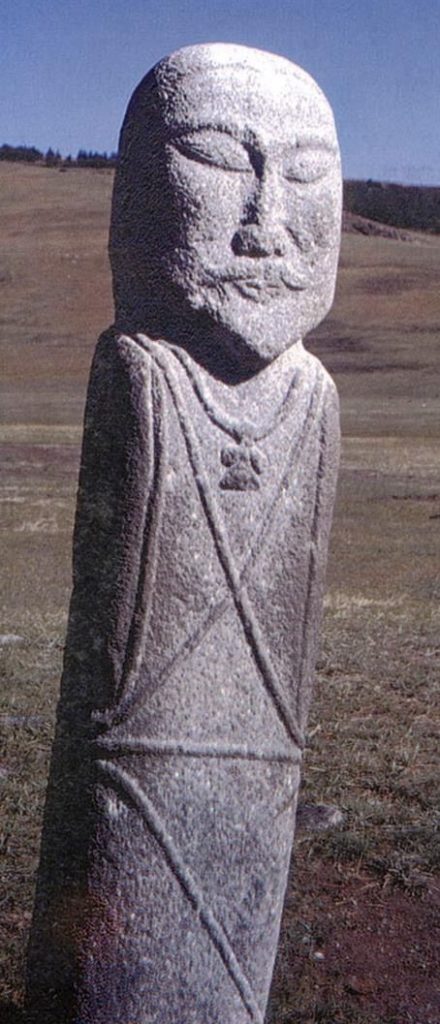
Unification of God Tengri as the Supreme God of all Turkic peoples and the entire Yellow Race and all Ancient Thunderers of European, Hellenic and all Eastern peoples
Etymology of Tengri in the Far East
Connection with Thor, Perun and other European Gods
Tengri’s connection to the Ancient Near East
Tengri’s connection to Zeus
Connections to Tangaroa, God of Oceania
The sphere of help
Traditional depictions
Nine worlds
Nine Chokyr and Animal Spirits
The symbol of the lightening
99 worlds
Three souls
Three suns
Omai
Shamanic medicine
The Trinity of God
Three Karmas
The Cult of Ancestors
The First Shaman Myth
The Heavenly Hunt
The Sieidi, Ships and Gates of the Gods: A Megalithic Civilization
Lake Seydozero
Barchenko Expeditions
The notion of the Eternal Heaven
Khasiyet and Khaseret
Back to the navigation
Tangara, Tangra, Tanyr, Tenir, Tigir, Daer – these are different pronunciations of the name of the same Supreme God of Sky, Thunder and Lightning of all Turkic peoples, of the entire Yellow Race, wherever it is, and of all peoples, in one way or another mixed with it, mainly we are talking about the peoples of Siberia and the entire East of the continent of Eurasia. This is the God of Heaven, Thunder Warriors, Lightning, it is also the root from which the verb to swear is formed in Turkic languages. This word is related to the Chinese character Tyan (Sky), and Tengri also means Sky, Crown Chakra. This is one of the most widespread Ancient Pagan Gods of the planet before the introduction of various forms of abrahamism, because he was honored as such by almost the entire Eurasian continent.
And here are some examples of its origins for the all-pervasive peoples of this region of the world (quote):
Back to the navigation
Altaic etymology :
Proto-Altaic: *t`aŋgiri
Meaning: oath, God
Turkic: *teŋri / *taŋrɨ
Mongolian: *taŋgarag
Tungus-Manchu: *taŋgura-
Japanese: *tinkir-
Turkic etymology :
Proto-Turkic: *teŋri / *taŋrɨ
Altaic etymology: Altaic etymology
Meaning: 1 god 2 sky, heaven
Old Turkic: teŋri 2 (Orkh.), 1, 2 (OUygh.)
Karakhanid: teŋri 1, 2 (MK, KB)
Turkish: tanrɨ 1
Tatar: täŋre 1
Middle Turkic: teŋri 1 (Sangl., MKypch. – CCum., AH et al.)
Uzbek: taŋri 1
Uighur: täŋri 1
Sary-Yughur: teŋer 2
Azerbaidzhan: tanrɨ 1
Turkmen: taŋrɨ 1
Khakassian: tigǝr 2
Shor: tegri 2
Oyrat: teŋeri 1, 2
Chuvash: tora 2
Yakut: taŋara 1
Dolgan: taŋara 1
Tuva: dēr 2
Tofalar: dēre 2
Kirghiz: teŋir 1, 2
Bashkir: täŋre 1
Balkar: tejri 1, 2
Karaim: taŋrɨ, teŋri 1
Karakalpak: täŋir 1
Salar: tanru (ССЯ) 1
Mongolian etymology :
Proto-Mongolian: *taŋgarag
Altaic etymology: Altaic etymology
Meaning: oath
Written Mongolian: taŋɣaraɣ (L 776: taŋɣariɣ)
Khalkha: taŋgarag
Buriat: tangarig
Kalmuck: taŋɣǝrǝg (КРС)
Ordos: taŋGarik
Dagur: taŋgarag (Тод. Даг. 165)
Tungus etymology :
Proto-Tungus-Manchu: *taŋgura-
Altaic etymology: Altaic etymology
Meaning: 1 to bow (in front of gods while praying) 2 to tell fairy-tales
Even: taŋrān- 2
Literary Manchu: tanǯura- 1
Japanese etymology :
Proto-Japanese: *tinkir-
Altaic etymology: Altaic etymology
Meaning: to swear
Old Japanese: tig(j)ir-
Middle Japanese: tígír-
Tokyo: chigír-
Kyoto: chígír-
Kagoshima: chìgìr-
The end of the quote.
Now you see the reach, and you understand what is meant when it is said that of the Four Princes of Hell, Baalzebul patronized the East of the Eurasian continent and the entire Yellow Race – its vast knowledge of internal styles of martial arts, Qigong, its impressive Taoist alchemy and medicine such as TCM, which is now literally alleviating suffering all over the world that no other medicine can either alleviate or clearly explain. I have studied extensively the origins of medicine in China, Mongolia and all the shamanic cultures of Siberia – they are all quiet identical and go back to the same root. With the only difference in terminology such as calling diseases “evil spirits” by mosy tribes. This is quite obvious. Everywhere similar concepts of the 5 elements, winds and everywhere similar methods of treatment. Some global explanations, such as 3-4 types of people according to the elements, are also akin to what was preserved from Ancient Greek medicine, the works of Hippocrates and Galen.
It may seem that the Turkic languages have their own unique roots, in no way connected with the languages of the White Race of the West. But no, there is a connection after all. It is Thor, the name of the God of Thunder and Lightning of Germanic-Scandinavian mythology. Both are images of Baalzebul. And there is also a connection to Sumer, the Hittite kingdom, and the Ancient Near East:
Quotes from different Wikipedia pages:
”
Tengri (Old Turkic: 𐰚𐰇𐰚:𐱅𐰭𐰼𐰃, romanized: Kök Teŋri/Teŋiri, lit. ’Blue Heaven’; Old Uyghur: tängri; Middle Turkic: تآنغرِ; Ottoman Turkish: تڭری; Kyrgyz: Теңир; Kazakh: Тәңір; Turkish: Tanrı; Azerbaijani: Tanrı; Bulgarian: Тангра; Proto-Turkic: *teŋri / *taŋrɨ; Mongolian script: ᠲᠩᠷᠢ, T’ngri; Mongolian: Тэнгэр, Tenger; Uyghur: تەڭرى, tengri) is the all-encompassing God of Heaven in the traditional Turkic, Yeniseian, Mongolic, and various other nomadic religious beliefs.
The oldest form of the name is recorded in Chinese annals from the 4th century BC, describing the beliefs of the Xiongnu. It takes the form 撑犁/Cheng-li, which is hypothesized to be a Chinese transcription of Tängri. (The Proto-Turkic form of the word has been reconstructed as *Teŋri or, the back-ablauted variant *Taŋrï.)[8] Alternatively, a reconstructed Altaic etymology from *T`aŋgiri (“oath” or “god”) would emphasize the god’s divinity rather than his domain over the sky. It is generally assumed the term tengri originally meant “sky”. Andrey Kononov suggested that the term is formed by the words tän (morning) and injir (evening) into tänri, referring to the sky as whole.
The Turkic form, Tengri, is attested in the 8th century Orkhon inscriptions as the Old Turkic form 𐱅𐰭𐰼𐰃 Teŋri. In modern Turkish, the derived word “Tanrı” is used as the generic word for “god”, or for the Abrahamic God, and is used today by Turkish people to refer to any god. The supreme deity of the traditional religion of the Chuvash is Tură.
Other reflexes of the name in modern languages include Mongolian: Тэнгэр (“sky”), Bulgarian: Тангра, Azerbaijani: Tanrı.
Earlier, the Chinese word for “sky” 天 (Mandarin: tiān < Old Chinese *thīn or *thîn) had been suggested to be related to Tengri, possibly a loan into Chinese from a prehistoric Central Asian language. However, this proposal is unlikely in light of recent reconstructions of the Old Chinese pronunciation of the character "天", such as */qʰl'iːn/ (Zhengzhang) or */l̥ˤi[n]/ (Baxter-Sagart), which propose for 天 a voiceless lateral onset, either a cluster or single consonant, respectively. Baxter & Sagart (2014:113-114) pointed to attested dialectal differences in Eastern Han Chinese, the use of 天 as a phonetic component in phono-semantic compound Chinese characters, and the choice of 天 to transcribe foreign syllables, all of which prompted them to conclude that, around 200 CE, 天's onset had two pronunciations: coronal */tʰ/ and dorsal */x/, both of which likely originated from an earlier voiceless lateral */l̥ˤ/. Linguist Stefan Georg has proposed that the Turkic word ultimately originates as a loanword from Proto-Yeniseian *tɨŋgVr- "high". Amy Chua renders the name as "The Eternal Blue Heaven".
Back to the navigation
“Parallels have been suggested with Sumerian Dingir (“Sky”), with Chinese Tian meaning “Sky”, and with Old Scandinavian Thor (Þōrr)”
The Old Icelandic word Þorr is derived from the Proto-Germanic *thunaraz, “thunder”. From it also came German. Donner, Danish. donder and English Þunor, transformed by epenthesis into English thunder. Swedish. tordön, Danish. donder and Norv. torden contain the suffix -dön/-den, meaning “rumble” or “thunder”. Scandinavian languages also have the word dunder, borrowed from Middle Low German.
Both words (“Thor” and “thunder”) are related to the Celtic taranis (Irish tarann) – “thunder” and “god Taranis”.
Roman sources identified Donar with Jupiter, but more often with Hercules (e.g., Tacitus in his “Germania”), probably because of the similarity between Thor’s hammer and Hercules’ club.
The name Taranis translates as “Thunderer” [or Thundergod], and is related to the Irish torann “thunder”[2]. Theologically, this God is the personification of thunder and in a number of devotions he was identified with the Roman Jupiter. According to the Celtic scholars Christian-Joseph Huillonvarh [English] and Françoise Leroux [French]: “Taranis by his name recalls the ‘terrible’ or ‘intimidating’ aspect of Jupiter. It could correlate with the military component of power.”.
Further etymology goes back to the pra-i.e. *tṛHon- “thunder, thunder god”, since the Celtic theonym cannot be separated from the name of the Anatolian thunder god Tarhunt: Hitt. dTarhu(nna)-, Luw. Tarḫunt-, from which the Etruscan names Tarhon and Tarquinius are also borrowed.
The Kashubian form of the name of the thunderer – *tagop’~ *t’gop’~ was borrowed from Celtic, which was used along with the original Slavic Perun.
Back to the navigation
Tarhunt (Tarhun) was the Hittite god of thunderstorms. In other Anatolian languages he bore the name Taru (Hattian), Tarḫu(wa)nt(a)- (Luwian), DEUS TONITRUS (rendering of Luwian hieroglyphs), Zaparwa (Palai), Trqqas / Trqqiz (Lycian) and Trquδe (Danish) (Carian).
Its equivalents in Mesopotamia were Adad (Sumerian), Adad / Hadad (Akkadian[5] and Teshub (Hurrian).
Tarhon (Tarhont, in Strabo’s Tarcon) was a character in Etruscan mythology. “Organizer” of the 12 cities of the Tirrens (Etruscan League). The city of Tarquinia is named after him”
“The Vedic weather god Parjanya [a variant pronunciation of the name Perun / Perkunas] is also called Stanaitnu (‘Thunderer’).”
And here we also see a connection with Satan’s name, Stanaitnu, and it means Thunderer. Proof that they are the same person. And Satan is exactly an Indian word.
Back to the navigation
Roman sources identified Donar with Jupiter, but more often with Hercules (e.g. Tacitus in his Germania), probably because of the similarity between Thor’s hammer and Hercules’ club.
“Jupiter Tonans (Latin: Ivppiter Tonans, lit. ’Thundering Jove’), was the aspect (numen) of Jupiter venerated in the Temple of Jupiter Tonans, which Augustus vowed in 26 BCE and dedicated in 22 BCE on the Capitoline Hill; the Emperor had narrowly escaped being struck by lightning during the campaign in Cantabria. An old temple in the Campus Martius had long been dedicated to Iuppiter Fulgens (“Lightning Jupiter”). The original cult image installed in the sanctuary by its founder was by Leochares, a Greek sculptor of the 4th century BCE.”
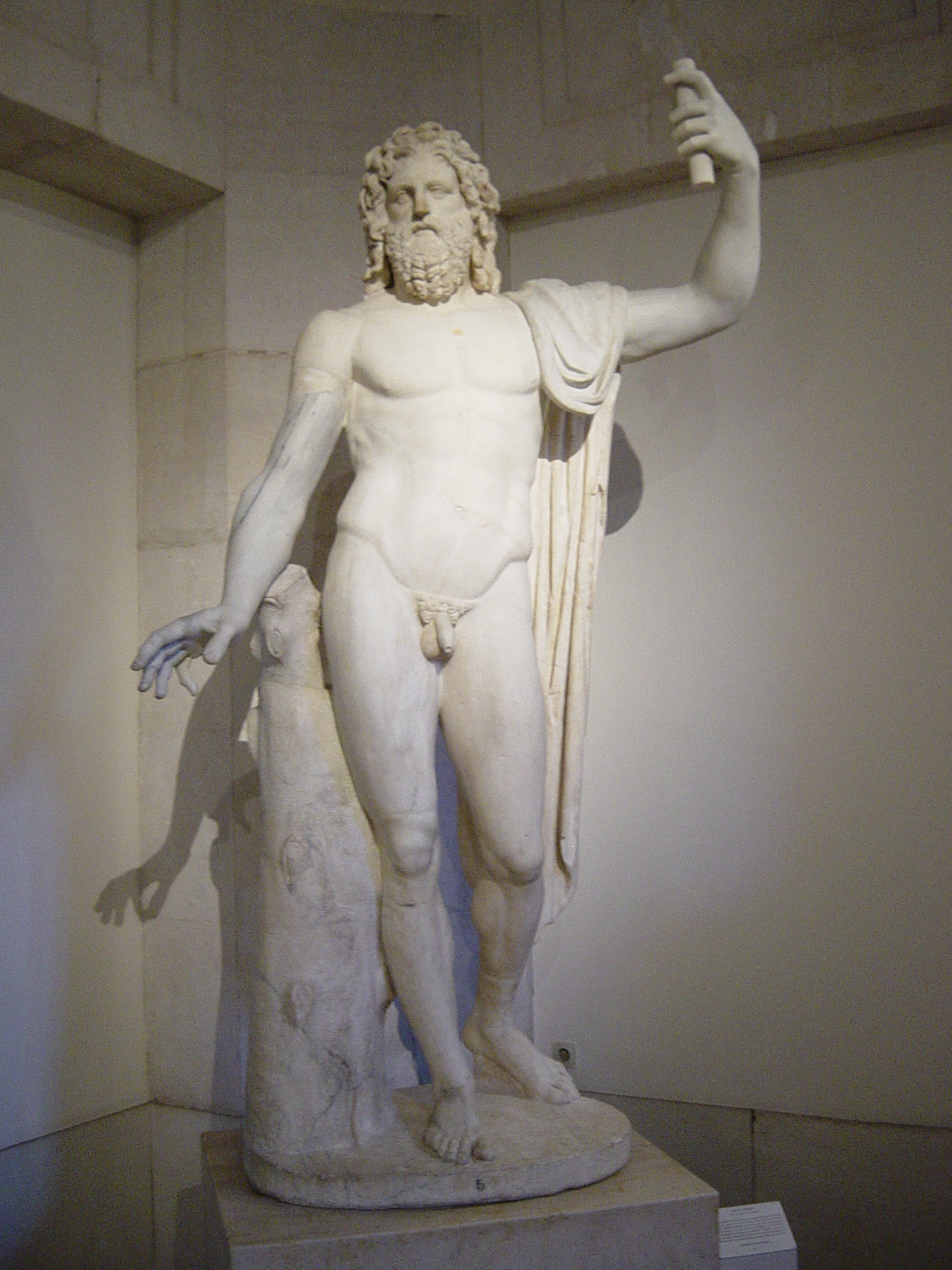
Sculpture of Jupiter Tonans at Museo del Prado (Madrid, Spain), possibly reflecting the cult image of the temple of Jupiter Tonans in Rome (Spanish Royal collection, Prado)
Back to the navigation
In some peoples, whose life is more connected with the ocean, he was the God of the seas and oceans, which corresponds to his hypostasis of Poseidon. But in this or that tribe there are mentions of him as the Supreme God of Heaven, as Tengri, and as the God who gave people fire, as Prometheus. In general, all myths of civilized peoples are repeated under different pronunciations of the word Tangaroa. The same cortent TN, TNG or TNG, TNGR, TNGL as a variation of TNGR.
“Polynesian God Tangaroa (Takaroa in South Island Māori dialect; cognate with Tagaloa in Sāmoan) is the great atua of the sea, lakes, rivers, and creatures that live within them, especially fish, in Māori mythology. As Tangaroa-whakamau-tai he exercises control over the tides. He is sometimes depicted as a whale.
• In Rapa Nui tradition Taŋaroa was killed at Hotu-iti bay and was buried in the surrounding area.
• In Ra’iātea a legend reported by Professor Friedrich Ratzel in 1896 gave a picture of Tahitian god Taʻaroa’s all-pervading power.
• In Hawaiʻi the God of ocean, healing, and long travels is called Kanaloa.
• In Sāmoa the God Tagaloa is the almighty sky-father deity, the creator of the universe.
• In the Marquesas Islands, the equivalent deities are Tana’oa or Taka’oa.
• In Rennell and Bellona Islands (Polynesian cultures in the southern Solomon Islands) Tangagoa is a sea God who stayed on the coastal cliff of east Rennell known as Toho, and flew in the night with a flame in the sky. Tangagoa was believed to take spirits of the dead, so when someone was near death, the sparkling fire would be seen at night. Some can still recall the time when this God appeared in the night as a flame in the sky, and have many tales of it. Tangagoa started to disappear in the 1970s and early 1980s when Christian missionaries visited the cliff and reportedly ‘cast’ him out.
• A legendary figure named Tagaro also features in the Melanesian cultures of north-eastern Vanuatu. In the beliefs of North Pentecost island, Tagaro appears as a destructive trickster, while in other areas, he is an eternal creator figure, and names cognate with Tagaro (such as Apma Takaa) are applied nowadays to the christian god.
End of all citations.
And so, we see that the root with the combination of consonants TR, TRH, TNR and TNGR (tangr, tengr, tinkr, and everywhere the letter T is interchangeable with D and K – interchangeable with G, as seen above) are present in the origins of also European languages, including from one of them, identical to the Chinese Tian (Sky), from which Tengri is derived, comes the modern English word thunder. And it goes back also to the Hittites and Sumerians. It is either a word from some one Ancient language of the Gods’ proto-civilization, which now all peoples pronounce differently, or a root left from such Ancient times, which go back to the dawn of mankind and beyond. And I might tell you that it is characteristic of the Yellow Race to preserve the most ancient knowledge in its best form and purity.
Besides, these letter-combinations are characteristic for mantras for opening the higher Chakras. English sound TH, as in the English words thing, throat, or its voiced version, as in the English words this, there, as is known, when vibrating opens and stimulates the pineal gland and Lunar Sixth Chakra and the Third Eye. It is the basis of the name of the rune Thurisaz in the name of God Thor, and accordingly, and Tengri and all the names listed above. Moreover, in the name of Tengri there are several such sounds: G – also a powerful vibration for the pineal gland.
Back to the navigation
As for his sphere of influence, it is everywhere God of thunder, warriors, military force, male protection for women and fatherland, and the embodiment of supreme power and Supreme God over all the Gods. Zeus is in this his thunderous aspect is especially patronized by overcoming obstacles, as well as his rune Thurisats, as evidenced by the concentration on the sound combination TX, inherent in all names, which, as we know, kaki rune, used in overcoming obstacles and removing blocks, as well as in rune combinations to remove obstacles from the path of movement of energies or in general from the path of life. A good example is the Russian word таран [sounds as “taran”] which means “ram” – it comes from this ancient word and means an object that allows you to crack obstacles and locked or jammed doors and gates. Exactly this aspect of Zeus is connected with the concept of breaking free, breaking through, Freedom and Uranus (Tengri everywhere where he is known is represented exactly as the God of Heaven and has functions of Roman Uranus). And when we do exactly the ritual of Baalzebul (right now we have two rituals for this God – the one for Satan and the one for Baalzebul), he is perceived as the God of Freedom and liberation, from obstacles, torturous blockages of Qi in the body and in the soul, removal of torturous captivity and social frameworks. Being the Supreme God over all Gods, he also works with the concept of power and is the God of defense against tyranny and abuse of power by those in authority.
This is one of the reasons why, besides the obvious much desired man’s protection he represents, women feel so deeply relieved by his ritual, as it removes the confines of bondage and forced restriction in an unwanted public role and gives a sense of much desired freedom to do what they love. In addition to bringing man’s protection to women, this God also aids in career and self-expression in their chosen endeavor and helps them find it. If you yearn to find yourself and find the one thing you can give yourself wholeheartedly to and wish to channel it to serve the society and the Temple of Zeus, this God can help you. Father Zeus is characterized by his ability to help in absolutely everything, and this is what distinguishes his identity in Siberia and the regions where he is known under the name of Tengri.
Back to the navigation
As well as Slav God Sventovit, this God is oftely represented holding a cup in the mdidle of his body in the area of the Solar Chakra. Holding Graal is the traditional pose in which Turkic stone statues are depicted, both male and female.
Yet the Graal can slowly be transformed into something else and both male and felame figures might be found in a very Acient position of masturbation – in Gebekle Tepe you might find 9K BC masturbating figures.
They also sometimes hold graal in one hand and sword or some other object – in another so that hands are usually in the position of one hand – n Solar Chakra, other – on Sacral one. This is also very popular Ancient pose for all Rusian territory – both Slav and Turkic regions.
Below the pose correlations.
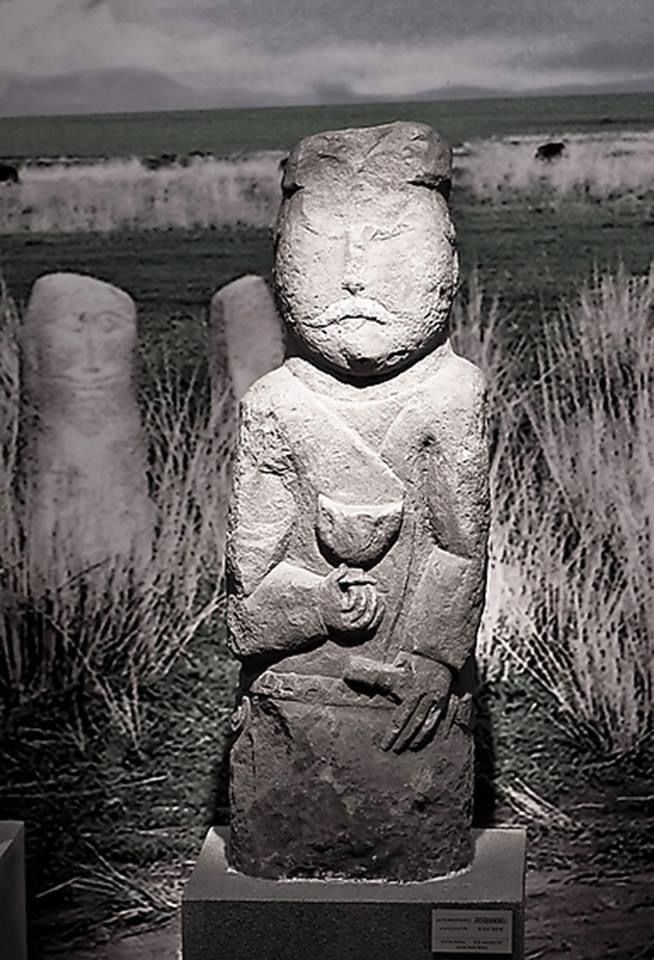
In one hand Graal, in another – sword or something.
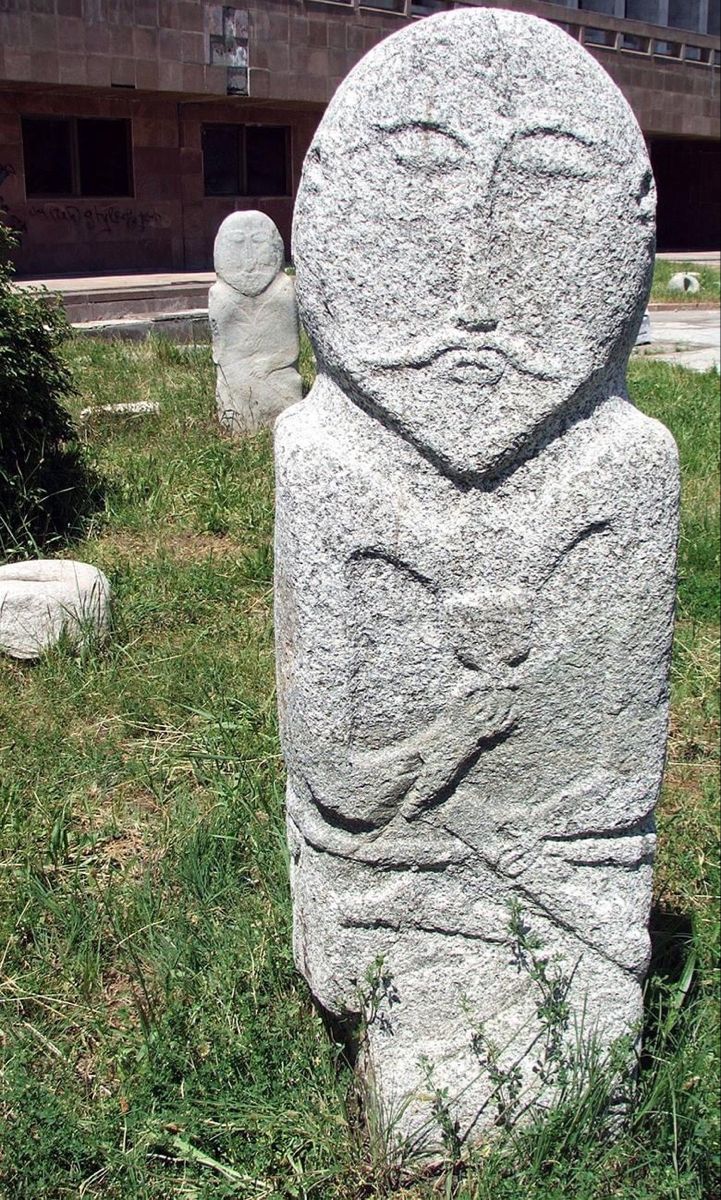
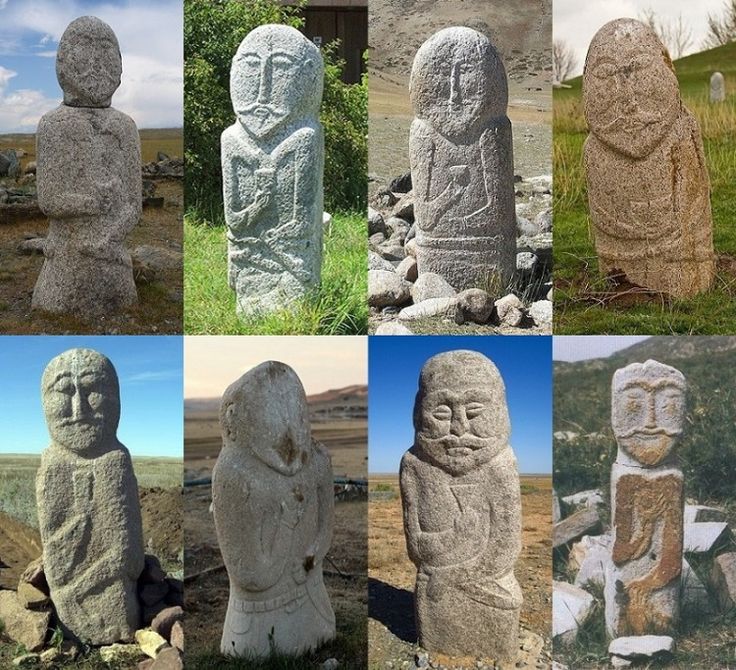
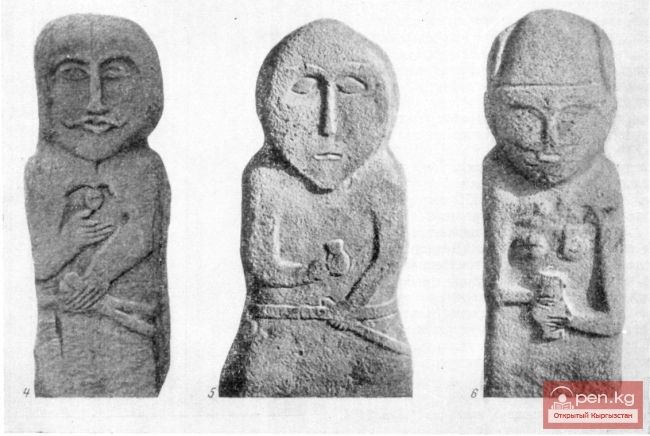
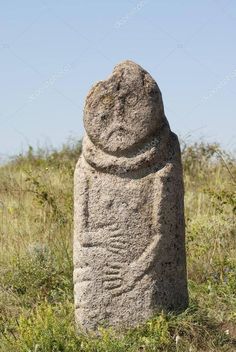 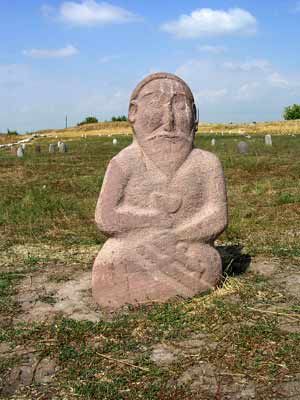 |
Pay attention: their hands are aligned so that one is on Solar Chakra holding Graal and other is on Sacral one holding some other object or free.
This is a very ancient hand pose. Slavic tribes also depicted their deities in this way – compare:

Gnezdov idol with his hands on Solar and Sacral Chakra.
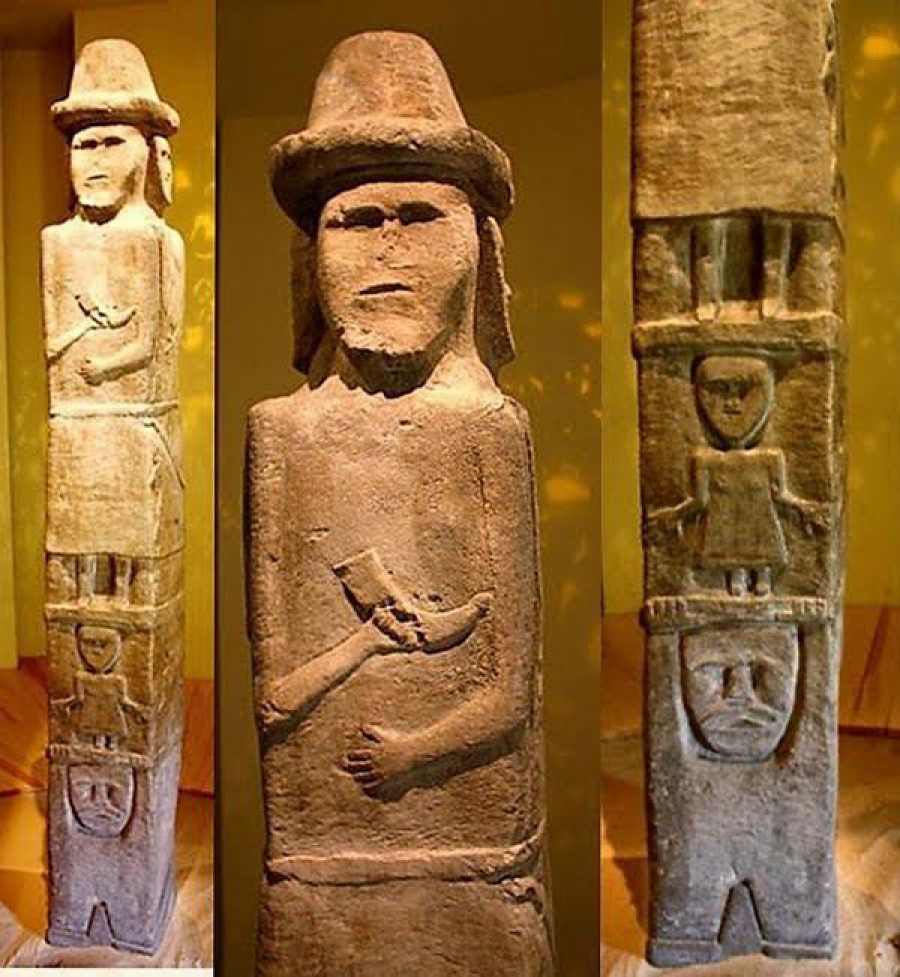
Zbruch idol with his hands on Solar and Sacral chakra, holding a cup – this is very traditional depiction of 4-faced Slavic God Sventovit.
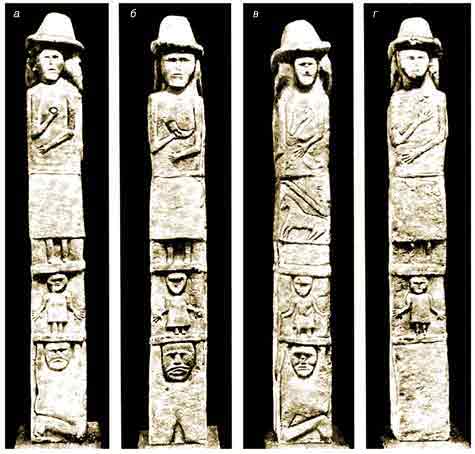
Zbruch idol 4 faces.
Next, see how smoothly this vessel in the hands transitions into a phallus, and how smoothly this hand pose transitions into masturbation in more ancient versions:
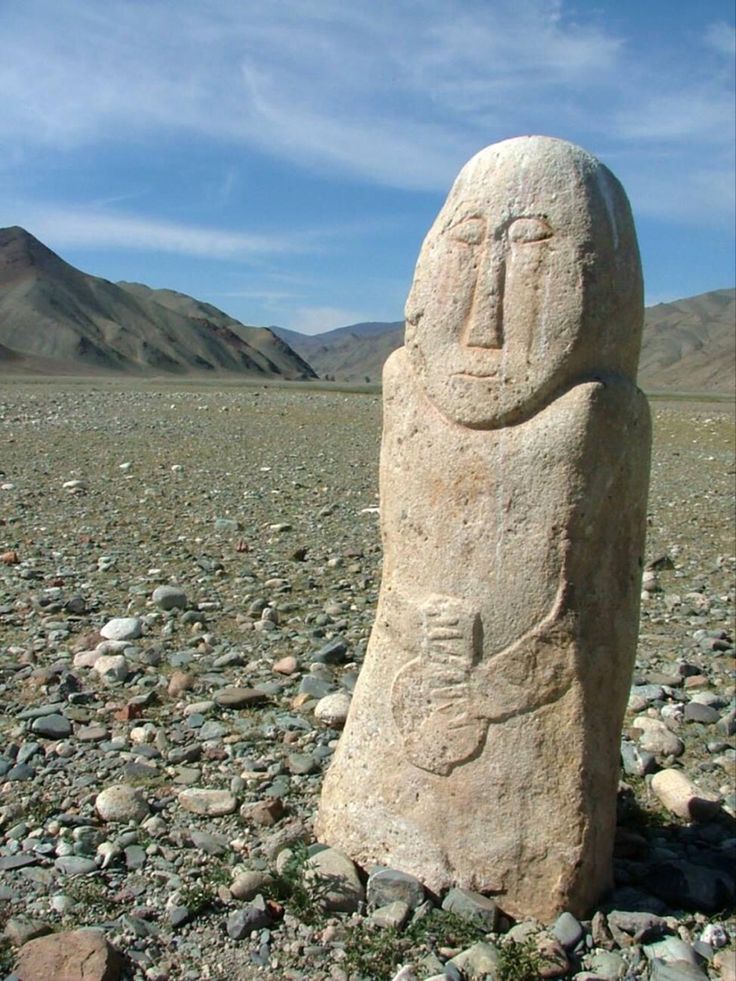 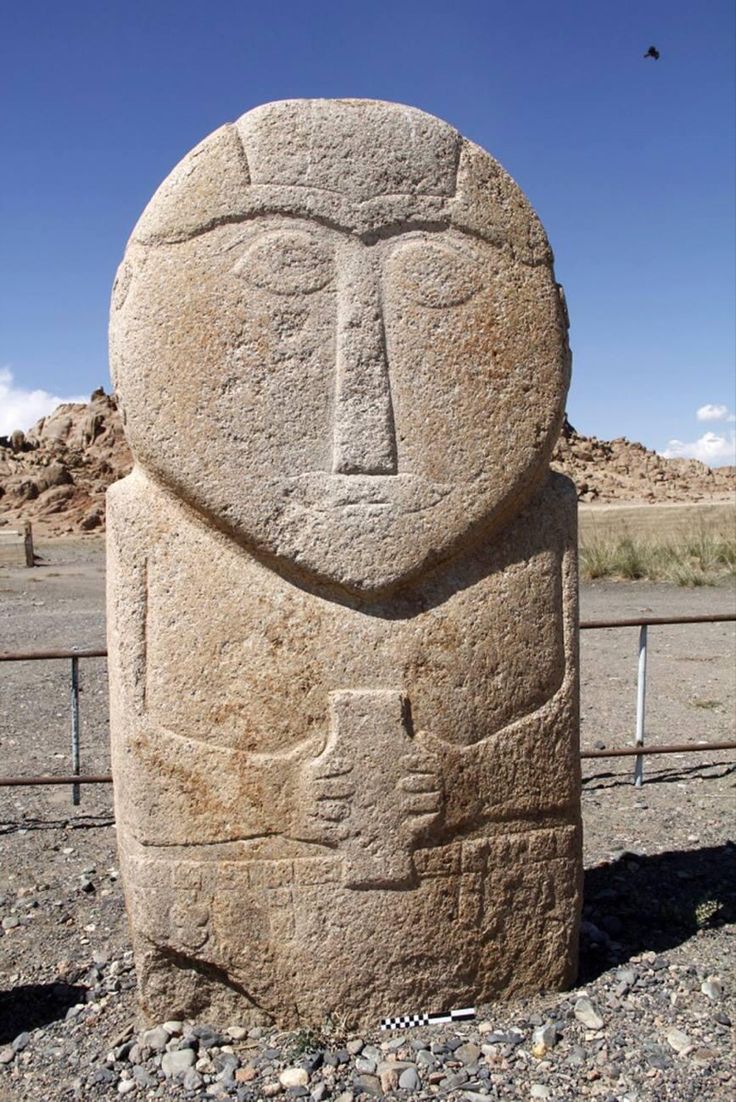 |

These are the most Ancient examples of masturbation maybe explaining the later tradtion to hold these two chakras. Masturbation is extremely Ancient symbol. It goes back to megalithic culture of 10K+ BCE, such as Turkish Gebekle Tepe and Saiburch megalithic Temples that are 11K years ago.
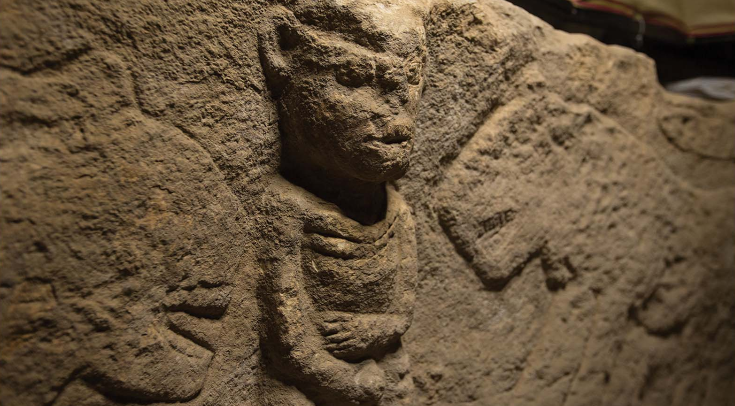
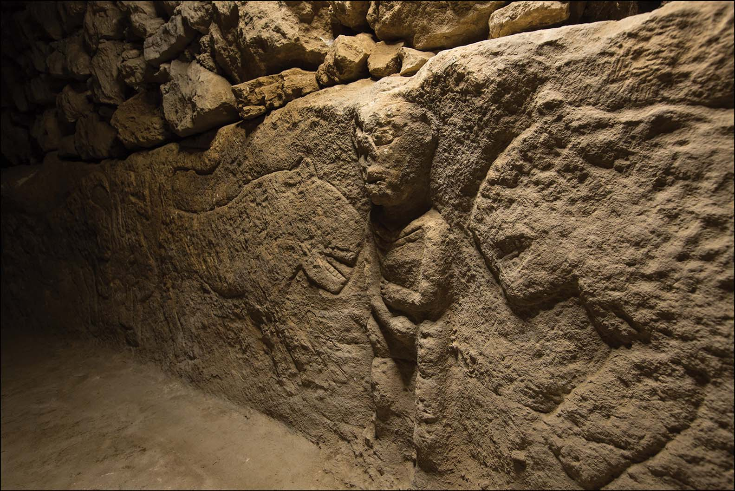
Sayburc. Turkey. 11K years ago. Masturbation and two leopards. Hands on the Sacral and Solar Chakras.
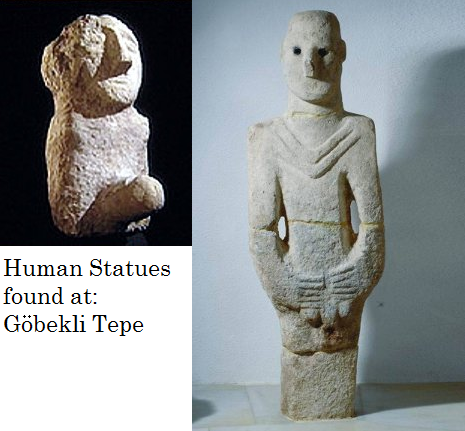
Gebekle Tepe, Turkey, 11,5K years ago. Masturbating statue with blue stones for eyes.
The fact that our main God, who personifies fatherhood, fatherly care and love, the responsibility of father and spouse, the responsibility of the emperor and spiritual leader for his state, was depicted almost from time immemorial masturbating, must have an extremely important spiritual meaning connected with these Chakras, and this is why later the hands were moved to them, and perhaps masturbation became a taboo for the image on the statue, because people began to take everything literally, and in order to prevent statues from being broken by such people “with the best of intentions”, traditional symbols of elements (Sword – air, Cup – water) were placed in the hands and those builders were satisfied with pointing to the Chakras.
The Lower Chakras are associated with Satan, and the Upper Chakras – with Lilith. From the Lower Chakras comes everything – both happiness and unhappiness – related to men, such as: Do your men protect your fatherland, do your police protect you, does your father care for you or has he abandoned you and your mother, does a woman’s spouse care for and love her or only drink at her expense, how do your men in your country treat women, do they honor and protect their maiden honor, are they responsible for their safety, do they escort them, do they carry heavy objects for them, or do they go to a gay pride parade instead. Do your men protect your borders, or do they put on makeup, put on pink underwear and a hairdo and rally for open borders.
All female happiness lies in the Lower Male Chakras, responsible for male behavior, and their proper purification. A woman, because of the shape of her inner triangle, stores up emotional pain in the abdominal area, while a man stores it in the chest area. It is logical that the God of the male energy of the universe reminds his followers and especially female followers where the protection, proper fencing of the nest from the outside world, security (male mining) and the male strength, male power and male love so desired by them come from.
The stone is that good, because it will preserve what is sure not to be preserved on paper and papyrus.
And here are female Turkic statues – they are also in the same pose with the Grail on the Solar Chakra or an object below and masturbating. These are the so-called “Stone Babas” of Siberia – there are many such images throughout Siberia.
Female masturbation is difficult to depict, as the female organ is hidden in the body. Therefore it is very symbolically depicted by a vessel under the Solar Chakra, which the woman holds in her hands – what can be more understandable than the symbol of the female element Water – Cup – in the place where the uterus should be.
Here is a photo of Stone Baba and the statue of Inanna, so that you understand how common, world-famous and recognizable this symbol is for the ancients.
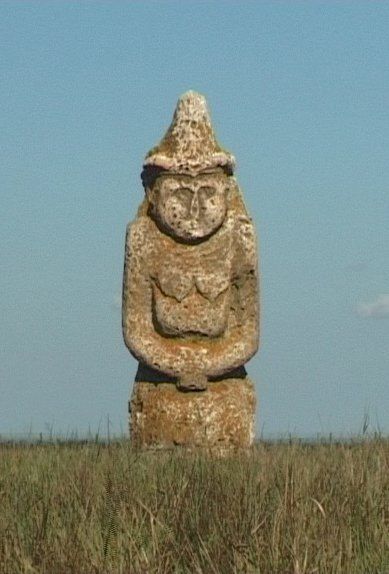
Stone Lady

Find more pictures here.
Back to the navigation
Speaking about the kinship of Germanic-Scandinavian and Turkic cultures, it is absolutely impossible not to mention the sacral number 9, which corresponds to 9 human bodies in traditional Turkic shamanism and 9 worlds in Germanic-Scandinavian and traditional Turkic shamanic cosmogony. Shamans also associate 9 worlds with 9 energy centers of the person and call them conditionally nine animals to which they symbolically put them in conformity, and participation of these animals in myths so it is possible to consider from this point of view. And many tales not only of Siberia and Mesoamerica, but mainly of these regions, for the most part are centered on the lives of these sacred animals, which opens in these tales quite other layers. Also these 9 worlds shamans often associate with certain areas of the human Soul and with about 9 Chakras, including 7 central Chakras of our body, one nasopharyngeal – between the Throat and Moon, and two, so to speak, spiritual formations under the Base Chakra, counting from zero they are 9, and if you count from one – and in general 10.
Animals also act as a system of nine bodies in which the shaman travels, thus it becomes clear how animals are parts of the Soul. But it must be said that in shamans bodies can be split and split, pulverized and pulverized, and one of the nine can also split into several, etc. I.e. bodies purely theoretically can be made an infinite number, if there is enough skill for it, or even a continuum.
As for the association with Chakras, shamans claim that this is not an exact correspondence, in particular the numbers may raise questions. As we know, our sacred numbers are 7, 9 and 13, and they are all associated with Chakras. The thing is that they count two more energy formations – one at the very foot and at the ankles or knees – there they supposedly count two more formations pus the traditional seven or even eight, counting the Nasopharyngeal Chakra which is between the Throat Chakra and the Moon Chakra. But the Temple of Zeus website also lists four Chakras above the head. All together gives 13 or 14 if you count from zero, and it’s a hell of a lot like the number of cards in one Tarot suit.
Back to the navigation
Further it is a very rare unique material from the first hand of a shaman, who explained to the author Olard Dixon the meaning of animal symbolism for the shamanic cultures of Siberia. And this is very important, because we can see animals on all monuments older than 4 thousand years BC. – This is an ancient language of forces and energies, and we even see it in the tradition of Ancient Egypt to depict Gods with animal heads. It is of course different for each area, as the fauna of each region is unique. It is like similar languages of the same language group: if you learn one, you can more easily understand all the others.
Spirits are also categorized into Spirits of the Lower Worlds and Spirits of the Upper Worlds, which is also clear in the context that Spirits are certain elemental, chakral and astrological forces. The Spirits of any worlds are not worshiped as Deities, they are invoked as elements and worked with.
We, the Whites, are a civilization that has always tried to explain everything logically and systematize everything, so we have created mathematics, astrology based on mathematics, and other systems of explanations and sciences. Sciences are an invention of the White Race or at best mixed races of Persians and Arabs. The Türkic peoples worked with all things Uranic without such an advanced Mercurian application such as the exact sciences. What we see in them and all shamanic cultures is an attempt to describe the different areas and realms of the human Soul in the language of animals and Spirits as a language of energies.
Further the quote goes.
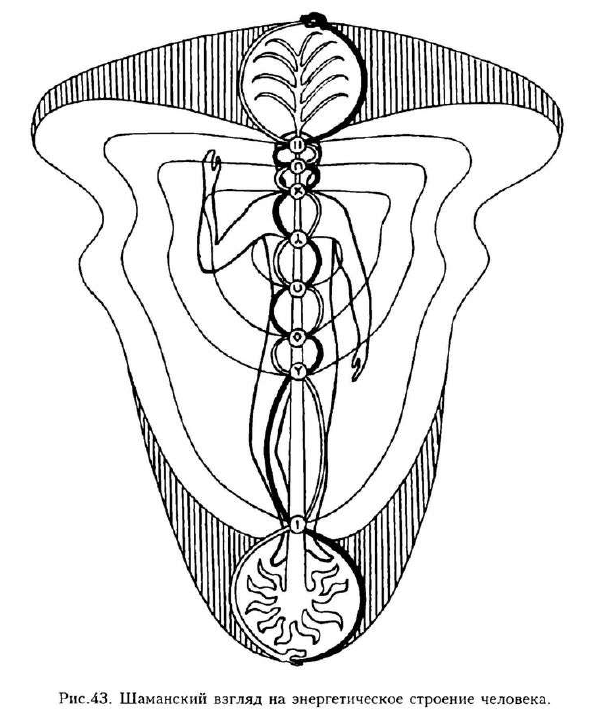
Translation: Shamanic view on the energetic structure of the human.
”
The shamanic view of the human energy structure differs from the common Indian model of chakras (Sanskrit “wheel”, “funnel”, “whirlpool”), which classically consists of seven centers and begins at the base of the spine. For the shaman, the axis on which all the centers of the chokura are located connects two points outside the body. One is the center of the material sphere of the Eagle, and the other is the center of the spiritual Heaven of the Raven. The mystical section from the lower kapu chokyr to the base of the spine is called the Pillar of the Earth. Reaching the sacral plexus, it connects through the spine to the Pillar of Heaven, the ends of which coincide with the base of the brain and the upper kapu-chokyr. Eight power centers are across this line, performing the functions of extracting, processing and storing the life force. Through three channels the life force circulates along the spine and through peripheral branches is distributed throughout the body. Energy channels as well as chokyrs are not anatomical formations. They form a special structure of electromagnetic radiation that fills every cell of the physical body with life and consciousness. Absolutely any kind of activity inevitably leads to the loss of part of the life force. Its restoration occurs mainly through absorption of food and breathing. A complete waste of vital force is tantamount to death, its improper circulation causes disease, and its overabundance often leads to mental disorders. The level of awareness and, consequently, and perception of an ordinary person does not rise above the third lower center, while in a developed personality it can reach the upper region. The Amur shamans say about such a person that his soul panyan has become a shamanic soul nyukta, i.e. electromagnetic radiation has been transformed into light, kaumanesthetic.
The eight chokyrs (without kapu-chokyrs) have a clear localization in the human body and projection to internal organs controlled by endocrine glands. Two kapu-chokyrs, as it was noticed earlier, are outside the physical body and have a direct relation to the development of certain ways of thinking and to the achievement of higher ideals of the supra-human order. Therefore they are called Gates through which consciousness can leave the material shell. Rotating in different directions, chokyrs create powerful energy vortices, which, penetrating the body, pour outward and create a multicolored mushroom-shaped cocoon (see Fig. 43). By the nature and color of this cocoon one can determine the diseases present in the body, the emotional mood, and the degree of awareness of a particular individual. Chokyrs are responsible for perception, movement, and feelings and are symbolized by one of the totemic animals. They perform an intermediary function between man, Earth and Heaven, therefore the whole energy system is sometimes identified with the concept of the soul, but it is better to interpret it from the position of subtle bodies.
Power centers of a person can be considered in pairs, as it is accepted in the shamanic tradition, but here they will be listed and described from bottom to top for better assimilation of the material.
The initial (zero) chokyr or lower kapu-chokyr is a spherical spot of intense luminosity of dark purple color, located under the feet. Its totemic ruler is the Eagle. Mystical symbol of the roots (sometimes branches) of the World Tree. Stellar correspondence of the hole of Polaris. Sacred sign:
![]()
On a physical level to this force center correspond feet on which projections of all internal organs are carried out. The main action is manifested through the extraction of the Earth’s power and the return of excess energy to the Earth. Chokyr of the Eagle serves as a kind of lightning rod, grounding element. He is the foundation of the Middle World and the cause of thinking in plants, animals and humans. It is often called Mother Earth, although it reflects neither male nor female.
Eagle is a dual Force, giving material embodiment, physical power, prosperity, life, but at the same time taking away this life, provoking withering, decay, death and oblivion. The Eagle is associated with the Guardian of the Sun, secondary light, physical fire, cosmic luminaries, as well as with the unrevealed Sun, the Void, darkness and abyss. In man this center induces aspirations for material goods, reproduction of the new generation, develops the mind, promotes rationalization and invention. In a word, the lower kapu-chokyr is the earthly law and the basis of civilization.
The first chokyr looks in altered states of consciousness as a tunnel-like hole of purple color, located on the line from the crotch to the ground at the level of ankles. Its totemic ruler is the Snake. Mystical symbol tail, The stellar correspondence is Alcor (“rider” of the Big Dipper). Sacred sign:
![]()
The serpent is path, movement, balance and stronghold. Its power center shares all these concepts and extends its influence to the legs, especially from feet to knees, and arms, from palms to elbows. In this chokyr are concentrated the basic physical constants, represented in shamanism in the form of the interaction of the spirits of the elements. The spirits of fire and air are given hands, and the spirits of water and earth legs. The fifth element through the Pillar of the Earth and the spine rises in the brain and is responsible for decision-making, choice. Therefore, the center of the Snake can be called the beginning of the path, characterized by hesitation, weighing “for” and “against” The imbalance of this chokyr provokes lethargy, depression, dull-wittedness and can lead to the development of neurotic states.
The second chokyr is perceived as a funnel with a spiral-like flow of red-colored energy. It is the end of the Earth Pillar and is located at the base of the spine near the sacral plexus. A wider part of the funnel comes to the surface of the body in the area of the perineum in men and the back wall of the vagina in women. Its totemic ruler is the Deer. The mystical symbol is the arrow. Stellar correspondence of Alkaid (this one of the Big Dipper). Sacred sign:
![]()
In Indian tradition, the Deer chokyr is the initial chakra, which contains the great power to awaken a person. In shamanic understanding, this center is connected to the previous two, and its potentialities can be represented by the head of a snake whose tail rests on the lower kapu chokyr.
The Deer Chokyr is responsible for human survival and self-defense. It is often seen as a link between conscious and unconscious processes, which can be discovered through shamanic experience. Being in an ordinary state, a person is unable to feel this connection and therefore has no memory of his past incarnations and cannot motivate some of his actions based directly on hereditary memory. The power center of the base of the spine spreads its influence on legs, from knees to thighs, and arms, from elbows to shoulders, and is also responsible for normal functioning of internal organs of the pelvis. It gives a person stability, self-confidence and the desire for beauty. If unbalanced, it causes cowardice, inexplicable anxiety and a sense of dread. In shamanic practice, concentration of attention on this power center is used just before traveling to other worlds, as the Deer contributes to the initial phases of the exit of the subtle body from the material shell.
The third chokyr has an orange tunnel luminosity centered in the lumbar plexus. It comes to the surface of the body at a point just below the navel. The totemic ruler of this center is the Tortoise. Mystical symbol of the shell. Stellar correspondence Mizar (zeta of the Big Dipper). Sacred sign:
![]()
The main duty of the Turtle chokyr is the processing of energy received from the environment, as well as its transformation and distribution throughout the body. This center has a projection on the internal organs of the lower abdomen and is responsible for the work of the kidneys, spleen and bladder. It activates sexual desires, not necessarily related to the production of offspring; makes the body harmonious and attractive to the opposite sex; influences the course and development of creative ideas. Turtle is the achievement of inner coherence, which is the basis for freeing a person from inner contradictions. When the balance between “want” and “can” is disturbed, there are problems with the organs associated with this center. On the contrary, proper functioning can be equivalent to purification, in which sexual energy does not enslave the consciousness, but becomes a powerful force that can lead a person to the knowledge of himself. On ancient ritual figurines, this chokyr was sometimes depicted as a large subcostal hole round or square (see Fig. 45). The hole served as a passage connecting the worlds and symbolized a niche in which the reinterpreted sexuality could give reasonable fruit and turn into a creative, constructive force.
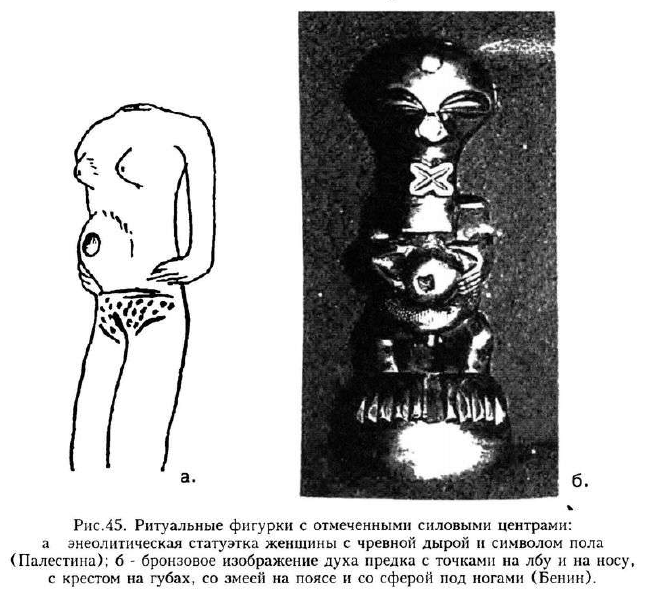
Translation: a) ritualistic figurines with the assigned power centers: eneolithic female statue with the belly hole and sex symbol (Palestine) b) bronze depiction of the Ancestor spirit with the dots on the forehead and on the nose, cross on the lips, serpent on the waist and sphere under the feet (Benin).
The fourth chokyr is a tunnel of golden-yellow color, located in the solar plexus area. Its totemic ruler is the Bull. Mystical symbol of the tambourine. Stellar correspondence Aliot (epsilon of the Big Dipper). Sacred sign:
![]()
The Bull is a very important power center. It is a kind of energy accumulator, a source of potential attainment of superpowers. When the sexual energy of the Turtle is transformed, it becomes the germ of true understanding of things. Further development gives great power, symbolized by the ancients by pregnancy, both male and female. Chokyr Bull is a decisive action, offensive, reflected in the person through such character traits as independence of judgment, unconventionality, brightness and desire for leadership. The organs dependent on the functioning of the power center of the Bull are concentrated in the upper part of the abdomen. These are the liver, gallbladder and stomach. Imbalance can lead to various diseases of the gastrointestinal tract and cause unstable psycho-emotional states such as irritability, dissatisfaction, envy and greed. The bull for the shaman, first of all, means spiritual growth and harmonious development. The power of this center is used for rituals of fire initiation, when the initiate is offered to walk on hot coals. Maximum use of the power center of the Bull makes the body immune to temperature fluctuations, allowing a person, at certain times in his life not to freeze in the cold and take hands red-hot iron.
The fifth chokyr looks like a tunnel with energetic luminosity of green color. It is located in the middle of the chest, in the cardiac plexus. Its totemic ruler is the Heron. Mystical symbol mirror. Star correspondence Megrets (delta of the Big Dipper). Sacral sign:
![]()
Chokyr Heron is characterized by emotional elevation. In it lies the abstract measure of love and hate, as well as the possibility of impartial judgment of these concepts. Together with the previous chokyr, Heron is the center of the human being, forming a kind of soul vessel. The work of this tunnel is often identified with the soul, as it reflects very well the inner state of a person through his appearance, habits, manner of speaking and thinking. In its highest development, the Heron power center gives a person calmness and inner silence. Words become unnecessary to indicate feelings. Clarity and understanding need no proof. In its normal state, Heron often confuses the definitions of love and sentimentality, compassion and feelings of self-pity. Because of this, more pity, longing, and grief develop without reason or with a contrived reason. Of the internal organs dependent on this center, the two heart and lungs can be distinguished. The endocrine gland is the thymus. In case of improper functioning, the cardiovascular system suffers most often. In shamanic practice, work with the Heron’s chokyr is of great importance, as it not only leads the seeker to the path of wisdom, but also contributes to the achievement of states of altered consciousness.
The sixth chokyr is perceived as a hole of blue color, located in the throat plexus, in the area of the thyroid gland. Its totemic ruler is the Spider. Mystic symbol a striped stone or stone with a hole (sometimes a chomus). Stellar correspondence Fekda (gamma of the Big Dipper). Sacral sign:
![]()
Spider is a fusion of masculine and feminine beginnings into a single whole through interpenetration. Idyll implies the presence of such qualities of character as internal aesthetics, balance of thoughts and deeds. But all this is true only in the case of normal functioning of this power center, which can be found infrequently. Unrevealed opportunities Spider makes a person unsociable, “gregarious” and prone to obsessive compulsive states. Therefore, this chokyr can be called the most dangerous and difficult in the spiritual search.
The power center of the Spider is closely connected with the throat and vocal cords. It is the connecting line between the shaman and the inner voice when performing divination operations. Shamanic journeys through the past and future do not do without the Spider center at all, as it is in a sense the present. It is given much attention during work in trance states, when realizing oneself inside a dream, as well as when playing the khomus and singing throat songs.
The seventh Chokyr has the form of a tunnel of blue luminosity. It is located at the base of the brain and represents the lower end of the Pillar of Heaven. Its totemic ruler is the Bear. Its mystical symbol is the ritual mallet (or sacred club). Its stellar correspondence is Merak (Beta Ursae Majoris).
Sacral sign:
![]()
Chokyr of the Bear is a force that pushes a person to overcome obstacles and achieve heights, sometimes abstract or utopian content. Being under its influence, a person often begins to realize the importance of collective achievement of the goal. He begins to look for his teacher, and when he meets him on his way, sometimes refuses to accept him as his mentor. This, as a rule, turns into an unjustified elevation over others, which in turn leads to the closure on himself and even more indulgence in thoughts of his own exceptionalism. Chokyr Bear is sometimes called the coordinating center, because it “monitors” the state of the surrounding world, both material and ethereal, and controls the reaction of the body to the signals received from the brain. It closely interacts with the occipital roots of the spinal cord and pituitary gland. Diseases caused by an imbalance in this tunnel are associated with impairment of the senses, especially smell, hearing and taste. There may also be more serious deviations in the form of various mental disorders, up to insanity.
The bear is a mystical animal that gives a person great physical strength. But he always takes something in return. Often when he offers his services, he takes away intelligence. Therefore, shamanic work with this center should be done very carefully, so as not to disturb the harmony achieved in the Spider’s chokyr.
The eighth chokyr is observed in the state of altered consciousness as a tunnel of dark blue color. The luminosity is concentrated in a point just above the spinal column, in front of the cerebellum. It comes to the surface of the body in the area just above the eyebrows. Its totemic ruler is the Tiger. Its mystical symbol is the quartz crystal. The stellar correspondence of Dubhe (alpha of the Big Dipper). Sacral sign:
![]()
Perhaps, the Tigris chokyr is the only center to which modern scientific thought more or less pays attention. However, this attention is mainly directed not to the funnel-shaped tunnel itself, but to the anatomical organ where its narrow part is located. This organ is called the pineal gland or epiphysis. The wide part of the funnel is projected onto the interbrow and is referred to as the “third eye” in most mystical-philosophical systems. This designation was directly caused by the capabilities of this power center, which are characterized by the ability to see things in their true light. Well-developed chokyr Tiger opens in a person a source of wisdom and extraordinary mental gifts, and in the case of imbalance provokes deviations in mental development, accompanied, as a rule, by headaches. In shamanism, work with this center is of paramount importance. It is well visualized and physically felt in the form of tingling in the lower part of the forehead. Concentration on this point serves as a bridge to the knowledge of the depths of the human self, and to the perception of other worlds. Concentration of attention on the Tiger’s chokyr can be used practically in any meditative technique.
The final (ninth) chokyr or kapu-chokyr is a spherical spot of violet color, located above the head. Its totemic ruler is Raven. Mystical symbol of the branches (sometimes roots) of the World Tree. Stellar correspondence Alrukaba, Polaris (alpha of the Little Bear). Sacral sign:
![]()
On the physical plane the power center of the Raven corresponds to the top of the head, and its main action is to extract the power of the Sky. Disclosure of the Raven’s capu-chokyr is not an easy and often unattainable task. He is called the Heavenly Father, the foundation of the Supreme Universe, the Completeness and the return to Mythological Time. In an incomprehensible way he merges into one indissoluble Whole with the lower kapuchokyr of the Eagle. This merger cannot be explained in earthly language. It can only be felt, being directly in front of the Gate, beyond which all restrictions are removed and infinity opens.
The center of the Raven induces in man aspirations for higher knowledge, enlightenment, search for contacts with other areas of the Universe. The ancients denoted its presence in man by the Sun rising from the head. But it was not a material sun illuminating the earth, but a spiritual sun symbolizing the Primary Light, i.e. light without a luminary. Emitting radiance, the upper kapu-chokyr of the Raven pours like life-giving rain into the human body and allows the seed of the mind, dormant in the lower kapu-chokyr of the Eagle, to germinate. The resulting tree connects the spheres and creates the Cosmic Bridge that the First Celestial Shaman left to humans as a legacy at his last kamlana.”
– Olard Dixon. Shamanic Healing.
Back to the navigation
Pay attention to the connection of the radical Slavic symbol of lightning Perun:
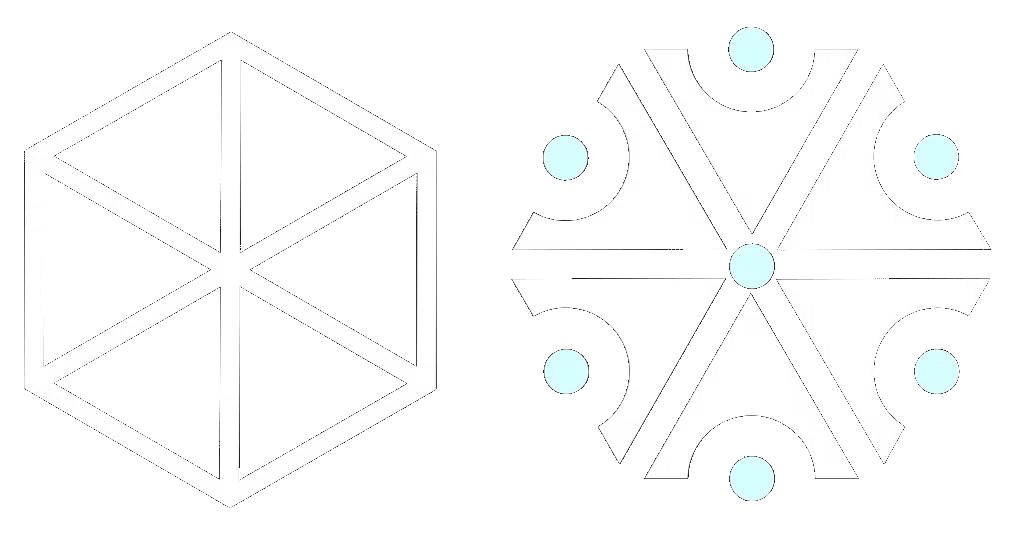
and the symbols of the Eagle and the Raven, which represent the same six-pointed symbol turned sideways so that when combined, they give 12 ends.
The raven exactly repeats the symbol of lightning. These cultures co-existed, and the Ural shamans in particular say that their culture was left behind by the White People of the Chud. Many nomadic tribes, as well as many wild tribes around the world, recognise that they received their culture from a highly evolved Race or Race of Gods that once lived in their territory, mostly describing it as the White Race.
Back to the navigation
This is as far as the Chakras are concerned.
As for bodies or worlds, as I have already said, according to the shamanic cultures of Siberia, they can split within themselves. And, no matter how many worlds there are, they are all ruled by one or another hypostasis of Tengri. Sometimes the detailing reaches up to 99 worlds, but even then each of them is ruled by one or another God, whose name ends with the word Tengri. Also Greeks called different Gods by the word Zeus, and Mesoamericans called different Gods by the word Tezcatlipoca, for example Red Tezcatlipoca, Yellow Tezcatlipoca, Black Tezcatlipoca etc.
Detailing always goes on the principle of multiplication by 9 and each of the worlds is always divided into three sub-worlds: the Highest, the Lowest and the Middle, all of which are ruled by the hypostasis of Tengri, just as in Ancient Greece: Zeus – the Highest World, Poseidon – the Middle World, Hades – the Lower World.
In each of these 99 worlds there are 7 layers according to the number of the main Chakras and 33 tiers, which refer to the 33 vertebrae.
“In the metaphorical picture of the megacosmos drawn by the great shaman Kara-baksy, the paradigms and archetypal symbols that substantively characterize the shamanic psychocosmos, cosmogony are compositionally highlighted. “Zengir de zengir zengir zengir kөk, Zengir kөkte tәnir kөp” – paradigmatic expressive model of the layer-by-layer ascending universe, in each layer, according to Baksy, there is a lord [Tenir as well as Baal in Sumerian obviously meaning lord here]. “Akikat ғой жетi қat aspan ekeni-ұлы Тәнір мекені”, – paradigmatic statement of the model of the seven-layer higher world – the abode of the great Tengri, the kingdom of truth. “Qaradan qaraadan qara zher,-qara zher assty tola el” – paradigmatic picture of layer-by-layer descending transphysical worlds, inhabited also densely. “Ғaryshtan ғarysh ғalam bar” is a complex metaphor conveying the isomorphism of each layer of the cosmos to a particular consciousness. “Kөktөbe” – the image of the world mountain, the Turkic Sumeru or Olympus; ‘bayterek’ – the image of the world tree, or metaphorical syncretic image of the entire megacosmos in the aspect of movement – growth; ‘tөrt bұryshty zherinde tөrt qubyla’ – the image of the earth with its four sides of the world; “Kubyla sayyn kөk teniz, kөk teniz sayyn tenir-tau”, – the image of the metaphysical primordial generating ocean, stretching along the four directions of light; ‘Kөk өgiz’ – a blue bull, supporting the entire universe, – archetypal image of some primordial timeless force (knowledge, energy), on which everything rests. ”
Worlds are simultaneously consciousnesses. This is also reflected in quantum mechanics and its concept of the Observer. In other words, different consciousnesses observe different worlds.
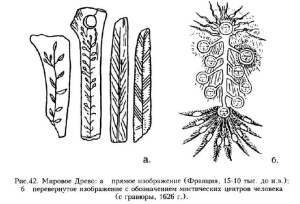
Back to the navigation
Like the ancient Egyptians, the Turkic people have several souls that behave differently. It is interesting that they have a concept of family tree, which was symbolically depicted as a real tree. It was believed that if the ancestral tree, i.e. the clan, was “torn out from the roots”, the souls of the ancestors of this clan would perish. And the Baksy (Kazakh shamans) mention that if the clan runs out, the souls of the clan may melt into dust on the astral, as there will be “no one to remember them”, in other words, whether they explain it by reincarnation or memorialization or whatever, they know that there is a so-called second death.
How human birth and life occurs:
“According to the Tăngrians, each person’s life begins in the celestial zone of the universe. Tәңре sends kut, kot (souls) of future children to the branches of the ancestral tree. In Tatar folklore, the tree nurtures (gives birth to) children, it is a symbol of life and a pledge of well-being of the members of the family. Through the family tree Tәңри sends kut (cat), tyn, sur to a woman. There came the womb period of human earthly life, during which the human body, consisting of meat, bones and blood, was formed. With the birth of a human being, the first sign of which was “breathing” (tyn, tun), came the period of a person’s stay on the “lunar-solar earth”. To uproot an ancestral tree means to doom to death the people connected with it by ties of kinship. Therefore, the ancestral tree was preserved, hidden, and not told to anyone about it.
Tatar-Tengrians believed that tyn (tun) belonged to living beings – people and animals. With the birth of a human being, tyn states the beginning of life. Tyn accompanies a person during the whole period of his life, until his death, until his breath is cut off (youne bette, tunu үzuldi). The Tatars believe that with the death of a person, the tyne located in the nasopharynx, in the lungs and in the oserdium goes to the upper world together with the last breath of the dying person.
The Tatar-Tengrians associated with kut the life force of man from his birth to his death. Kut (kot) is the life force, the very essence of life, of divine origin, coming from the Cosmos. Kut as well as tyn is an inalienable substance of a living person. Kut (cat) has the ability to leave the human body during sleep arbitrarily, in the form of a small fire. Kut uses the nasal openings for exit and entrance. Sometimes a sleeping person sees it wandering around different places in a dream. This kut in the shell of sur (human form) leaving the body, wanders to places where the person has once been, and returns when the person awakens. Kut (cat) can leave the body and involuntarily, for example, during a fright said: “Kotym chykty” – “Kut came out”, during entering a trance or hypnosis. Mostly kut (cat) returns independently, but sometimes the help of a kam or a clairvoyant is required. Therefore, a sleeping person (especially a child) was awakened carefully so that the kot (kut) could return to the person’s body while the person was still awake. Loss (kot) kut always entails misfortune – it is a disease, if the loss is temporary, or death, if it was irretrievable. The loss of kut, as well as tyn, leads to death. From the word kut came the derivative words kutla, kutlu, kutlat, etc.
Tәңри gives a person sur together with kut, týn. Sur grows up and grows together with a human being. It was believed that sur contains the inner psychological world of a person. Sur is translated into Russian as “ appearance”, “image”, “reflection”, but this translation does not correspond to the exact meaning. Thanks to sur traveling kut outside a person become visible to some people. It happens like this: one person tells another person that he saw him in such and such a place, although this person was not there. He replies to the designated person, ‘Perhaps you have seen my sur’.”
A description of all Souls and their nature:
“Cuth. The triune substance of man kut consists of matter and spirit: the earthy material substance buor-kut – the material body of man. The informational genetic component of a human being transmitted to him through maternal, parental blood is iye-kut. The divine spirit salgyn-kut is a spark of God, an etheric substance inhaled by God Tengri into the infant’s forehead at the first breath.
Tyyn. In the Tengrian tradition, each person is suspended from the sun, star, with invisible solar rays, threads tyyn, at the tip of which there is a divine etheric substance. The idea of its fiery-air (uot-kүөt – fire-air), light nature is connected with the concept of kүөt, which is associated with a blacksmith’s fur. With the approach of death, the sun-air threads – reins youyn stretched, shortened – youyn kylgyr. When tearing the reins – tyyn fastar, the death of man comes and salgyn-kut together with tyyn leave the body, ascend back to Tengri-Creator along the sacral path – Ak Zhol, Ayyy Suol, Ar Chol, etc. In Kazakh, “youң men zhan shygady” means that the soul leaves with the breath. The concept of “youңыштық” means peace, rest and tranquility, hence the concept of “youңық” – stoppage of breathing and blood circulation, i.e. the onset of death. The notion of “tyn” forms another semantic field connected with the notions of the primordial, untouched, pure. “Tyn zher” – unplowed, untouched, but fertile land. “Tyn kishi” – a person with a pure mind ”28.
Sur means the vital energy depending on the inner unity of the three forms of the human substance kut, its manifestation and self-development.
Oibon is in Yakut Tengriism a category identical to the Hindu chakra. These are the centers of concentration of kut and sur, located in the inner (subtle) body of a person. A vortex that reflects the idea of oibon as a vortex of psychic (cosmic, vital) energy is burkhan, burҕa.
[Above we saw it as 9 Chokyr].
Өrkön is the ray, the highest vibrational oybon. Reflects the connection of kut with spiritual consciousness.”
Back to the navigation
Probably the most mysterious concept is the concept of the Three Suns. In general, each of the 99 worlds has its own suns, moons and stars. At that, there are three Suns in each of the worlds. The first and initial Sun or Heavenly Fire is the Sun of Tengri, the External Sun, which, allegedly, appeared at the Explosion.
And here it must be said that the word Ten-Gri itself breaks down into two: Ten / Tian is Heaven, as we have already found out. Gri is something like Sun, Fire, or Manhood.
“The fact that Fire and Light belong to the main essential characteristics of Tengri as the Absolute, combining both spiritual and material beginnings in a non-dual in nature transcendental essence, is evidenced by the very term denoting this phenomenon, consisting of two root words: 1) “TEN”//“Tan”//Schumerian. “din”// Chinese. “tan“//”tan”//Russian день [pronounced as den’] “day” etc.; 2) ‘gr’// ‘hr’// ‘kor’// ‘kor’// ‘khor’// ‘gor’// ‘gar’// ‘gur’// ‘kur’// ‘gir’// ‘ra’// ‘er’// ‘er’// ‘eri’// ‘eri’// Kit. “ri“-”zhi“//, variants-”kol”// ‘gal’// ‘kolo’// ‘khoro’// ‘gallo’ etc.”
Pay attention, ten also means number 10. Thus this might reveal some of this number’s numerological characteristics (see below in the Notion of the Eternal Heaven).
“The first root word clearly manifests the meanings “dawn”, “day”, “daylight”, “sunlight and fire”, “morning dawn”, “sunrise”, etc. The second root word is “solar masculine,” “Sun,” “man,” with which is associated the concept of “Sun God,” who is in the visible Heaven and is represented as the Sun-Heavenly Deity. This ‘Sun’ is the ‘Second Sun’ which is the ‘outer’ Heavenly Sun in relation to Man and to the ‘Inner Sun’ of the Earth.”
Further, it is necessary to tell separately about the main Supreme Goddess of the Turks, known most often as Omai, Ymai or Umai, which means mother. And further I want to tell a myth about her, so that her connection with our Goddesses becomes clear.
Back to the navigation
According to all shamanic Siberian myths, the Supreme Goddess was directly involved in the creation of the world. She is traditionally, like Tengri, depicted as a bird, namely, waterfowl that populate the region of the belief, most often a loon or any other duck. And this is akin to Lilith, who was also depicted as a bird from the earliest Sumerian myths, which was also a symbol of her elusiveness. Appearing as a giant bird in particular, according to Sumerian myth, she rescued mankind on her wings during cataclysms born of its madness or the madness of its superiors.
According to shamanic myths this loon flew over the world’s primordial ocean and she had nowhere to sit and lay an egg, so according to some of the myths she laid it directly in the air, according to others she dived to the bottom of the ocean and lifted the earth from it until continents were formed, at which point she laid an egg there, from which all life emerged. Because of the creation of dense earth, she is called Mother Earth, which in turn relates her to Astarte. With Astarte and Astarte’s sigil she is also related to the fact that she combines the 5 elements that make up a person, as will be seen further from the description of traditional shamanic medicine, and in this sense she is Mother Earth.
The thing is that in Siberian shamanism almost everything has its Goddess and the amount of Goddesses is actually infinite. Everything has a mother: Mother of Water, Mother of Fire, Mother of Earth, Mother of Air, Mother of Wood – all five elements, then Mother of Sun, Mother of Moon, Mother of Stone, and in principle Mother (i.e. Spirit) of anything. And, just as almost all Gods were called [first name]-Tengri (as a surname or something like a second name in Latin Americans), so all these mothers in some way converge to Omai. So, Omai is also the Mother Earth and she also has the Entire Sun or the Inner Fire, which is not surprising if she is also the Mother of Fire. And in case a woman cannot bear a child, as there is not enough warmth in her womb, there are rites to the Goddess asking her to share her maternal fire to warm the child. And in the myth of the three Suns, we see that Mother Earth has her own Fire or Sun. In TCM this corresponds to Ming Meng, and all five mothers correspond to the five organs.
The third Sun is the Inner Sun of Man, which combines the Sun of Tengri and the Sun of Omai.
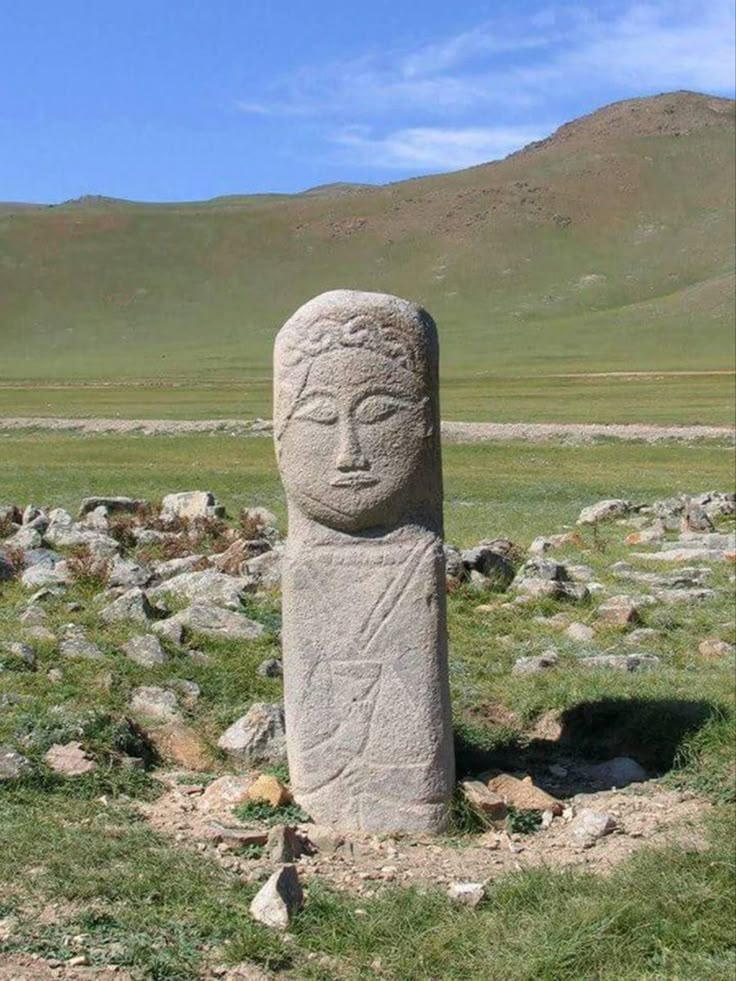
As well as Tengri, she was depicted holding Graal on her Solar Chakra.
Back to the navigation
“The power that connects man and the universe, says Nenets shaman and master of Arctic martial arts in the style of khokhorei min Ivan Kylalovich Yadne, manifests itself in the form of two energy flows: the descending flow of Nebatyu (muy) nyonya, which has a positive, male radical, and the ascending flow of the Earth – tasi (ngaya) nyonya, which has a negative, female radical. The combination of the two flows (radicals) forms the energy potential of a human being”. The power coming from Heaven has the character of heat and fire, while the power rising from the Earth is identified with cold and ice. ”
Diseases come from three things, as in Tibetan medicine: cold or ice (wind disease), heat or bile (bile or heat disease), and mucus or phlegm (damp or phlegm disease). Obviously, the first ones come from below, and in Ayurveda they correspond to unbalanced unbalanced Vata dosha, the second ones come from above, and in Ayurveda they correspond to unbalanced Pitta dosha, and the third ones come from the middle, and they correspond to the Earth element and unbalanced Kapha dosha. And this makes sense, because despite of what part f the body is targeted by the imbalanced Doshas, they may have different pain syndromes corresponding to each of them, for example, Pitta pain syndromes usually manifest as headaches, Vata pain syndromes usually locate in the lower abdomen where Vata originates, while Kapha usually destroys Spleen and everything it rules.
They are called evil spirits and are “expelled” in the process of kamlanie. The way of exorcism is in most cases approximately the same as in Western astrology, i.e. an attempt to sublimate the energies that create problems in a better direction – to symbolically feed the “spirit” with something else or to symbolically exchange the captive Soul of a person for something else.
And these three forces correspond to the areas of the Lower, Upper Chakras and the Snake connecting them. And also the triune God.
Back to the navigation
In Greek mythology we have Zeus, the Lord of Olympus, Poseidon, the Lord of Illusion, and Hades, the Lord of the World of the Dead. And this is a single God of three persons. At the Turkic also the world has three components – the Upper, Middle and Lower world, and all of them are controlled by three hypostases of God Tengri and are responsible for the above-mentioned areas of the human body and Soul and the elements and sources of diseases in case of imbalance.
Our cosmogony is very closely related to the structure of our Soul and our health.
Further on the drawing made by a Nenets shaman, you can see all three worlds and where the orthodox хians stole their orthodox cross from – it is an ancient symbol of the Supreme God.
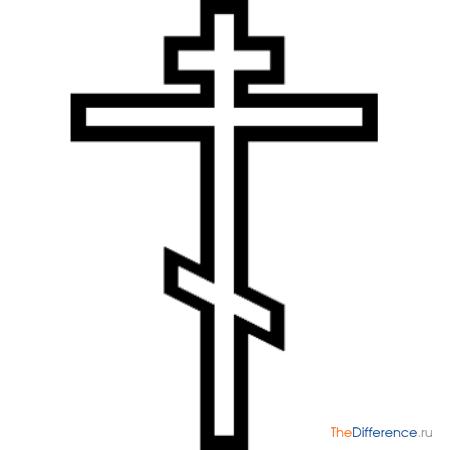  |
The distribution of powers of Heaven (Небо), Water (Вода) and Earth (Земля) in the human body. The drawing of the Nenets shaman Ivan Yande.
At the Turkic Water, i.e. water illusory aspect of God, Poseidon, is also in the middle. Poseidon connects the Lower and Upper worlds, and this is the property of the Serpent Satan, from which Jesus Christ was stolen on the cross. Because the Serpent Gods are traditionally depicted on the Tree, crucified or hanged. Poseidon as an image of the King of the Sea, is characteristic of Slavic legends, and he also there often appears in the image of the Lizard or Dragon. The Lizard or Mammoth (Mammoth is the national name of the mythical Lizard or Snake, it has nothing to do with mammoths in relict zoology) belonged originally to the mythology of the ancient semi-mythical White people Chud, who inhabited the whole Siberia and the whole Russian North up to Karelia from time immemorial and according to some legends went underground shortly before the appearance of christian conquerors in these lands, according to others – much earlier in the course of a mysterious war with other mythical creatures, and sometimes with local nomads. And this their Lizard, aquatic and terrestrial, passed on to the shamans of the local nomadic tribes of the Yellow Race, where it mostly became known as the Mammoth.
Back to the navigation
As in the case above, the three distinct aspects of the Soul are sometimes also expressed in three aspects of what it is formed from, I would say this is close to the understanding of different karma. Namely, there are three Souls in the sense of its origin (in brackets will be my speculations on how this might be related to karma, since origin is karma):
- Heaven-Soul (its own karma or karma that came from Heaven from Tengri, i.e. what was given to Tengri and what the Soul did with it as it traveled)
- Mother-Soul (the part of karma that came from parents and ancestors, all ancestral talents and misfortunes)
- Earth-Soul (perhaps an aspect of the karma of the physical body, as these are the elements that shape the incarnation, as well as the opportunities the planet provides, the conditions of physical existence)
Next, a little more detail. There are three axes – gifts-misfortunes. Gifts on one side of the each axes, misfortunes – on another.
One is the spark of Tengri himself, which is in each of us and connects us with him, his voice inside us, and how much we have followed it throughout the history of our Soul, and how much we have realized it in the case of talents. The trials here are only what we ourselves have under-done with our gifts. Kasiet and Kasret – see the corresponding sub-article further on.
The second is all hereditary karma. The Turks attach special importance to it. Without a complete thorough knowledge of your family, it is impossible to realize yourself, because you literally do not know your talents and misfortunes. For them it’s like an astrological natal chart for us. All hereditary diseases, misfortunes, bad karma of the family, when someone in the family did not follow the path of Dharma, – everything that the ancestors did not solve, and that was left for you to solve and solve. Also, everything they accomplished – you can refer to all of it. The article below will clarify this even more.
The third is the conditions of the planet, what it has to offer. This is planet-wide karma. Nobody thinks about it now, but we have destroyed the planet by the 21st century. We have depleted the earth and it has stopped producing fruits and vegetables that have enough minerals in them that both we and our animals have to supplement with vitamins. By destroying our habitat, we are seriously compromising our own health and the health of future generations – which is why this is seen as a form of karma. Another aspect of this is how we have poisoned her with curses running through her Ley lines. We absorb that karma as well.
Back to the navigation
Knowledge of one’s family and lineage is the most important thing in the opinion of not only shamans, but also Siberian Turkic peoples in general, because it gives an idea of all the “gifts” and problems that are put in front of a person, because they exist in his family. I.e. for them, this science of their own kind is something like our astrology, like a map of the soul’s path – what to be afraid of, where to move and what to realize. It is as if they see their whole destiny, knowing the history of their family. When they know the history of their lineage on all lines, they can read their destiny like an open book and predict their future with great accuracy, because they thus recognize their Mother-Soul completely with all her karma.
Their Helping Spirits, besides the animal-totems already mentioned, include the so-called Ancestral Spirits. This is especially true of prominent figures, usually shamans.
I have already said somewhere and everywhere that the Saturn line on the palm is usually underdeveloped in the peoples of these nomadic cultures, and it is considered to be more developed in cultures building high technological civilizations. I also say everywhere that a really powerful realized Uranus cannot be without a well realized Saturn. These are the two planets that build urban high civilizations, that make civilizations leave traces in history.
Why I consider Saturn to be the foundation of all further advances in the field of so-called Higher Destination, ruled by the higher planets. The fact is that in those Dark Ages, when the three higher planets had not yet been rediscovered by our recent ancestors, it was to Saturn that their qualities, such as genius, were attributed. In particular, I have seen it mentioned that it is the Mercury-Saturn aspect that brings genius, while in later times it was attributed to Uranus. Also the Dark Ages, as well as the northern nomadic peoples, are not usually characterized by a life expectancy that precedes the return of the higher planets. So the age after the first Saturn return is often the age of the greatest achievements and the greatest wisdom available. And about the Saturn line I learned this fact about its small distribution among primitive tribes from books based on the achievements of astrologers of these very periods.
Maybe the Saturn line is also developed because of constant writing with pen / pen on paper, sculpting, drawing, i.e. holding in the hand constantly some object of creation, why it is so associated with high development and contribution to evolution. The point is that shamanism and its shamanic disease epilepsy is ruled by Uranus, and perhaps these people are the few among these peoples who leave any tangible mark on their history.
It is said of them that they do not dissolve into dust like ordinary Spirits, but can live in the higher realms, and their aspects as Assistant Spirits can come and assist the living in their rituals, quite on the same principle as when we call upon the Crowned Princes of Hell.
Back to the navigation
In the myths of all nomads there is the so-called first shaman or shamaness, as well as the notion of the shamanic gift, and not only the shamanic gift, as something that exists independently of humanity and of which individual shamans are only a local expression. See further the article on Kasiet is that very notion.
The first shaman is that first ancestor who receives for the first time from the hands of Tengri the first two karmas, and inherits the third, the planetary karma.
The figure of the first shaman, who gave rise to all shamans, is often associated with the image of the Raven as the lord of the 7th Chakra. And, if it is a man, he marries the daughter of Ulgen (another name for the Supreme Creator God), in other words, he receives knowledge from our Supreme God. In the article about Lilith, the Princess of this World, I have already written that to be related to the Deity is an allegory of receiving knowledge from him.
Back to the navigation
Also known as Cosmic Hunt best source for which being the investigation of Russian ethnographer Yuri Berezkin.
Probably the most important popular calendar myth of all Siberian and northern peoples, including those of the north of Europe and America, is the myth of the Heavenly Hunt. It is known in ethnographic literature as the Heavenly Hunt, because it is engraved in the sky by the constellations of the Great and Little Bears and Orion, peculiar to the northern sky.
This myth is reduced to a hunter or bear chasing a deer or elk with the sun in its antlers. Sometimes the reindeer or moose swallows the sun, and sometimes the bear swallows the sun with it, or simply kills it and facilitates the release of the sun back into the sky. Or the release consists of the deer giving the sun to the fawn and dying in the claws of the bear, and the fawn further carries the sun across the sky in its antlers. The bear, aka the hunter is often referred to as Torom-Tiermes or Aieke. The word Aieke is related to the word Ukko. And I have already said that the word Ukko is close in sound to the English word Oak, and many names and epithets of the Thunder God of the Slavs, Germanic-Scandinavians, Balts, and now the Sami, Lapps [also known as Sami, Eastern Sami or Laparians] and other northern yellow peoples, mean Oak.
“God does indeed have many names. The most famous of these are: Horagalles, Garangalles, Horojurius, Tiermes, Toraturos and Pozdne, which means ‘divine thunder’, and Aya, which means ‘grandfather, great-grandfather’ in Sámi.
All of these names seem to be related to the sound of thunder. For example, Khoragalles, which is similar to the Scandinavian name for the god of thunder, Thor-karl. And the name Tiermes, which was the name of the god of thunder of the Eastern Sámi (Loparians), resembles the name of the celestial god of the Ob Ugrians – Torum. Perhaps this name is connected with the deity worshiped by the common ancestors of the Sámi and Ugrians in the era of the Praural community.”
“The image of Aieke and other manifestations of thunder was formed under the influence of ideas about the Estonian thunderer Eike and myths about the Scandinavian thunderer Thor. Like Thor, Horagalles was the patron of fertility and granted victory in battles. He rode the clouds in a blue robe and, when angry or pursued by trolls, split rocks with thunder and lightning. To temper the fury of the thunderer, a male stag and a hammer moistened with sacrificial blood were sacrificed to him.”
It is quite clear that the latter atrocity is a later perversion. The male stag or male elk with his exquisite antlers was quite understandably his sacred animal like the goat in the midlands, but in those circumpolar regions where goats are not found. He is quite sheepishly a symbol of sexual power. The moose or deer is also associated by shamans with the Base Chakra (the first formation of the seven that are in the body) associated with Satan and Hades aspect of Zeus. Chakras or Worlds are also called Suns, and that Sun, which in us corresponds to the Basis Chakra, according to shamanic ideas warms the back wall of the uterus in women. From here I remembered the association of many psychics of uterine myomas with problems not only of the Sexual but also of the Basal Chakra, myomas often appear on the back wall.
Shamans themselves recognize that their system and the Chakra system have the same roots according to the ideas of more southern cultures. Their ideas about medicine are also very close and almost identical and even have the same names with Tibetan ones, which in turn are close to Chinese ones, known to us as TCM.
The bear was considered as sacred animal of one of hypostases of Zeus at Slavs, namely Veles. And it was also identified with the hunter who kills a deer. One sacred animal, or the God-hunter himself, kills another. In the Ancient White Siberian people Chud and the Siberian shamans who adopted its culture, this hunt is often depicted also with a third sacred animal, namely a bird, an eagle. This is an image of the three worlds and how the shaman gains power over them all, allegorically one animal devours another, and becomes eaten by the third, higher it, or allegorically one animal rides another, and another carries on its back the third.
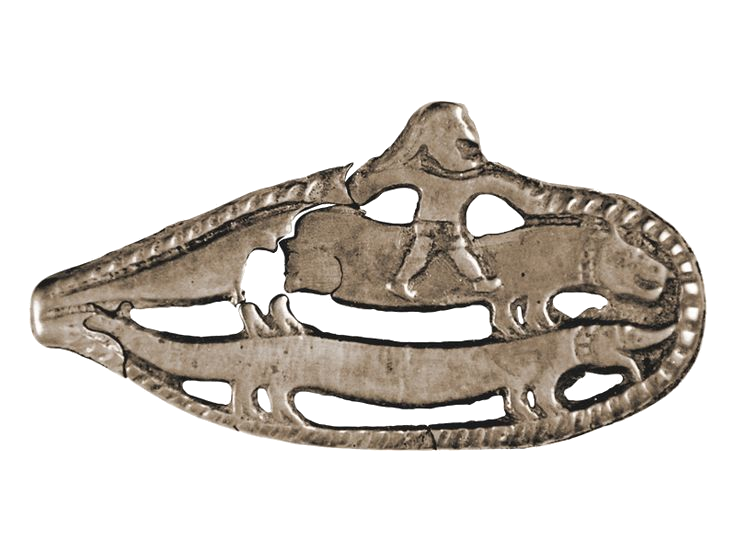  |
Artifacts of the Ural Chud found in Perm, Siberia
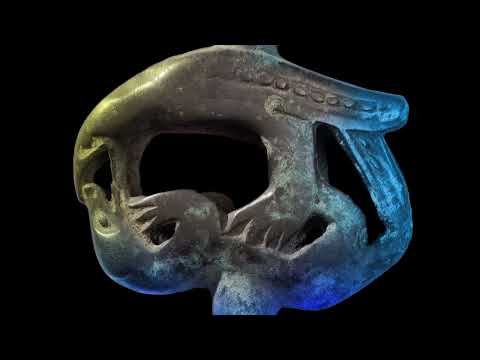
In Slavic myths it is symbolically depicted as a hunter aims at a wolf, the wolf dies and a hare jumps out of it, which he ate before that, and also rushes to escape, the hunter shoots at the hare, and the hare dying spits out a duck, which flies up, the hunter shoots at it, and an egg falls out of it. And in this egg of death of the Russian God of death.
Megalithic Pracivilization
Back to the navigation
«The Loparians [or Lapps] had few idols. Usually they made images of two gods: Aieke, a wooden one, and Storyunkare, a stone one. They also honored seids – sacred stones and cliffs. The stone was considered the dwelling place of the sieid, but the Lapps also honored the stones themselves, considering them sacred. Wooden idols of the Sami thunderer Khoragalles, according to the 17th century German scholar Johann Schaeffer, were depicted with a hammer in their hands, and a nail hammered in their head with a piece of flint.”
Our God has many professions, Storyunkare is a hunter and patron of hunters, while Aieke / Ukko (Oak) is a thunderer, perhaps why he was partly depicted as a wooden one.
The sieidis (seidi or seids) mentioned above are multi-ton stones placed on smaller ones, and traditionally their name is translated as inaccessible afterlife, magic or magical power. Such structures are known in all parts of the world, but are particularly concentrated in India and Karelia, Russia. In India in particular, one large stone was originally known as the Vishnu Ship (Brahma, Vishnu, Shiva – Indian trinity of Zeus) before becoming more popularly known as Krishna’s Butter Ball, which is the name by which it is now found on the internet.
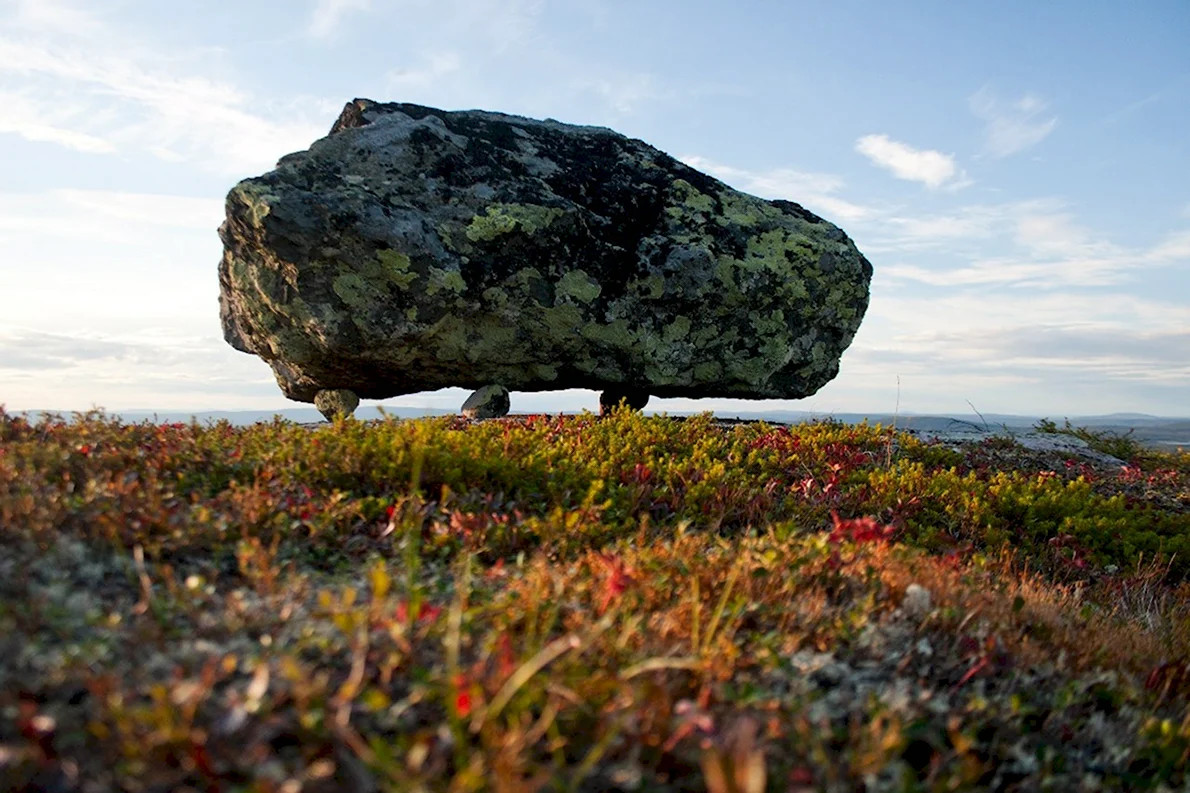

Sieidi of Karelia, Russia
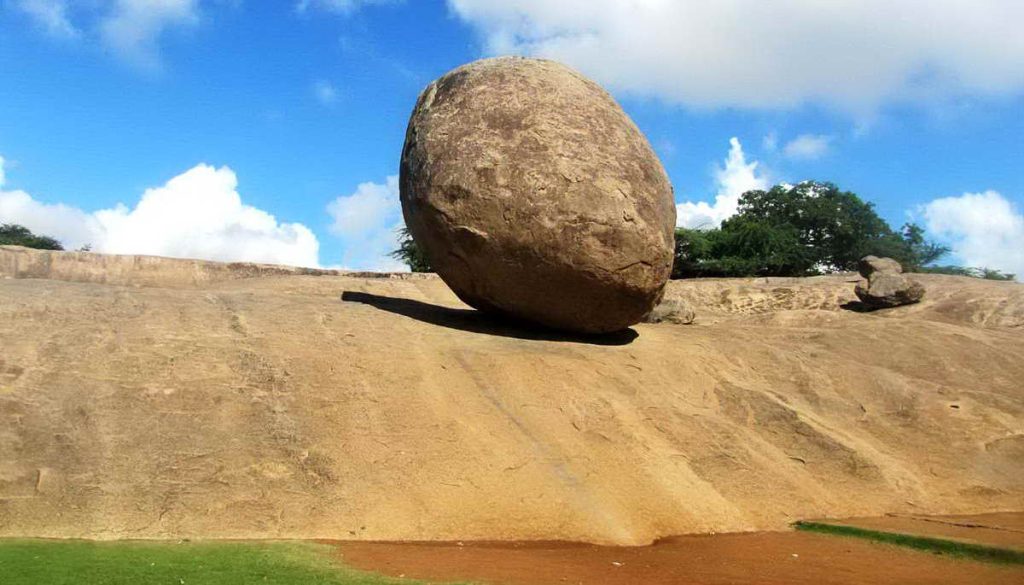
The ship of Visgnu (later known as Butter ball of Krishna)
Shamans consider seids as gateways to other worlds and a convenient point of reference for their shamanic journey. Local tribes often say about megaliths in all parts of the world that they are passages to other worlds. Many such legends about the Gates of the Gods were recorded in Mesoamerica. Of these, the most famous is the Gate of the Sun, through which Heroes and Gods went to the worlds of Heroes and Gods, and sometimes returned to instruct their descendants. The same Gate in duplicate exists in Turkey and is known as the Gate of Mger (Mithra), i.e. of the Sun with the same legend of its purpose.
At one such Gate of the Gods in Peru, guide Jose Luis Delgado Mamani set up an experiment: he recorded flying balls of light and other objects on his equipment. He also saw these gates and the light coming from them and all these effects in a dream before he saw them live.
Mamani claims that in his dream he saw a path leading to a doorway made of pink marble, and that he also saw a smaller door that was open and in it was seen “a brilliant blue light emanating from what looked like a shimmering tunnel.”
I believe that the Seids are an object of concentration and deep meditation, and then they reveal their true nature and ability to become the Ships of the Gods.
Back to the navigation
All Siberia is studded with ancient megaliths, but Karelia is especially studded with them, and I believe that, judging by ancient legends that all such megaliths are maps of transitions to other worlds, including physical, including underground, those of us who will learn to read the language of megaliths, will understand the topology of the Earth and how to get there. In particular, they will reveal the partial meaning of the statement of Thoth Trismegistus:
Know ye this Earth is but a portal,
guarded by powers unknown to man.
Yet, the Dark Lords hide the entrance
that leads to the Heaven-born land.
Know ye, the way to the sphere of Arulu
is guarded by barriers opened only to Light-born man.
– The Emerald Tablet of Thoth the Atlantean (Hermes Trismegistus).
One of these places is Seidozero. The following is a rather revealing story of how its exploration was stopped by one Soviet execution.
“As a result of many scientific expeditions it was possible to collect some facts that indirectly point to the possible existence of underground cities near Seidozero. Thus, in the 90s of the last century, scientists found rock writings, ruins of structures made of stones and rectangular slabs with even holes.
Also near the lake, researchers found fragments of a wall that could have been a defense structure and a well with a foundation. All these land finds are unlikely to be of natural origin.
Scientists did not give up hope of finding evidence of the existence of the city and at the bottom of the lake. As a result of its survey in the early 2000s, they managed to find some wells 70 centimeters wide, which went under the mountain. Deeper exploration was hindered by a large amount of silt.
As a result of the survey of the valley near the lake, the instruments recorded a kind of void, which began after 9 meters of soil. ….
Back to the navigation
Alexander Barchenko was nothing less than an OGPU professor of brain research, a Chekist, conducted successful experiments on telepathy, hypnosis, researched superpowers, and was essentially used by the Soviet authorities to create psychotronic weapons. The Soviets, as has always been the case in the Soviet Union, sent him themselves to investigate the mysteries of the Kola Peninsula, and after getting the results of the research they could get, killed him themselves. Officially, he went to investigate the psychic phenomenon of meringering in the Far North. Gathering legends, he came across a legend that in such a far distance from Siberia and Perm here, in the middle of the north-western tundra among the Sami, there lived the White-Eyed Chud. So the Chud, it turns out, lived throughout the territory of the destroyed Russian Empire. It seems that the whole continent was inhabited by such peoples as Tuatha de Dannan and Chud, who some time ago, as if by conspiracy, went under the ground, and the earth all of them contained. And so it happened that the last Chud princes left through that very cave, for information about which Barchenko was killed by those who just sent him for this information, seizing 99% of all the photographic material made by him.
Further in this place visited the Ahnenerbe.
Hyperborea is mentioned in ancient Greek sources as the abode of the Gods and the civilization of Zeus, from which some Greek Gods trace their origins, whose political system and life is close to that of the ancient Greeks, and which still had a Golden Age at the time of its description by the author. And the legends mentioned above literally say that some aspects of this country may have been moved over time to underground cities. And the same is said about another local country of the Gods by the Inca legends associated with their megalith known as the Gate of the Gods, mentioned above and explored by Mamani. And in general these legends tied to some megaliths and local passages to the Land of the Gods, the megalithic world is teeming with them. This and the fact that all megalithic constructions of the whole world are connected by the general geometrical schemes with which it is possible to get acquainted in details in sources to the article, suggests that on the Earth originally there was a megalithic civilization belonging to Zeus, passing from world to world, but that these entrances were intended for Heroes capable to see them and to use them, and that to the modern person capable to see only three-dimensional world, only a little part of it is open.
With the permission of the special services, Barchenko searched for similar entrances in many places, including the Altai, the Caucasus and Tibet. As did Roerich. In pre-war time Soviet authorities, as well as Nazi authorities, were very fond of such searches. According to his concept, the Northern civilization (as well as some other ancient cultures) knew how to split the atom, knew the ways of mastering inexhaustible energy sources and possessed the means of psychotronic influence on people. And the information about that has not disappeared, it has been preserved in coded form, it can be found and deciphered.
Back to the navigation
Tengri in most Turkic languages is basically translated as Heaven. This is quite interesting. The thing is that when researchers began to understand what exactly the Turkic people call Heaven, and whether it is only the visible dome above the head, on which the sun and luminaries walk, it turned out that they mean rather Aether – the space where everything appears and where everything disappears.
“L. Dashnyam, developing the idea that the Mongols’ word tengar encompasses all things and phenomena of this world, notes that ‘Heaven is – great being, great power, immeasurable influence, a transmitter from which unusual signals spread, becoming human domain’. [Here obviously astrological idea is present]
The Tuvan researcher O. M. Khomushku notes, “in ancient times, the traditional beliefs of the peoples of Sayano-Altai developed the idea of the Absolute, the sacred, divine beginning. Such a supreme deity was the sky. The sky in this understanding has a boundless space, where there is the Little Bear, the Big Bear, nine planets, nine heavens (Tuv. – tos de’er) and others. Such a storey was interpreted as a hierarchical step pyramid analogous to the social ladder of human society”.
L.A. Afanasyev-Taris defines the concept “ayyyy” as a category, and a basic one at that, to understand the worldview tradition of the Yakuts on the basis of the study of the mythology of the epic heritage. Where “ayyy” is Yuryung Ayyy Toyon (Yuryung Aar Toyon) is the Bright, White Lord Creator (Bright, White Great Lord). He is the creator of the nine-tiered Heaven – the Universe, all living and non-living, material and immaterial, as well as his assistants sitting on the nine tiers, defined as good, light ayyys/creators, in fact being once ascended to heaven immortal souls of righteous relatives, ancestors. This concept is identical to the Khakass Togys Chayan – Nine Creators. Taңara, Ayyy and Aar, in E.K. Pekarsky’s Yakut dictionary, made on the basis of comprehension of Yakut mythology, epic, folklore and historical materials, are explained as follows:
14- Taңara means – 1) visible sky; sky as a deity 2) God [P.2551, Pekarskii, vol.3];
– Ayyy [from ai: cf. Alt. jajȳ, Turkic people ajy] – creation, creation, creativity, creative beginning; ”
This is the space where wave functions dwell before they collapse. And it is the same sky we see in our horoscope – with the nine planets and all the signs of destiny.
The Ayyas, who represent essentially the Olympian Gods or pantheon, are the creative aspect of this world Aether. And this makes pretty much sense because to become creative innovative geniuses let alone Gods they have to go through cleansing and evolutionary process. And our planetary forces also before becoming siddhe and endless source of creativity, are fatal and unruled raw and mostly hostile forces of nature.
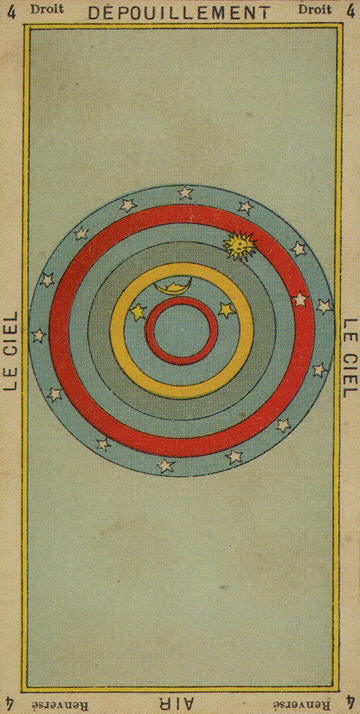
Here, I believe, the best way to illustrate the essence of the Turkic concept of “Heaven” is the Tarot deck of Etteila and its card Heaven (left), which corresponds to the Star card in the traditional Marseilles deck (in one of the deck’s variants, the picture corresponds exactly to the traditional picture of the Star card). On that variant of the deck, which does not have similar pictures with the Marseilles deck, the night sky full of stars is depicted. Meditating on them and on the traditional image of the Star in different decks, I felt the coldness of space and eternal Ether and realized that a very important sphere of this Uranus and Aquarius card is a portal to other and higher worlds and communication with the Gods.
God Uranus is the God of Heaven, Space, Ether, Astrology, because astrology is the sphere where the wave function operates before it collapses and where the material aspect of this world is formed before manifesting in it. When they say Uranic, they mean that which has not found material embodiment and exists in the realm of probabilities and dreams, or is an accessory of more subtle divine worlds.
It turns out that Turkic people see Tengri as the Ruler of the unrevealed destiny before its manifestation, as well as its manifestor, because the Heaven, the position of the planets and stars dictates what reality will be. Astrology is pre-reality, that stage of reality when it can still be controlled. And this science is ruled by Uranus and Aquarius, as well as the sphere of the Tarot Stars. It turns out that Tengri is the Lord of Destiny. And this also makes him Cronus and Saturn, because Saturn is reality at the stage of its emergence and fixation in material forms of manifested and hardened destiny. Uranus is reality at the subtle stage, when it can be controlled, which marks its connection with the concept of Heavenly Freedom. Math is under Uranus because it is the science of Ether, where its probabilistic laws apply and all its numbers exist.
When I did the Baalzebul ritual and meditated on his sigil, I perceived him quite clearly and 100% of the time as the God of Freedom, of removing blockages, of stagnation, of being behind technological progress and all the sciences. Now I realize this is because of his Uranic aspect. And it is this aspect of him that the Turkic people worship.
great lesson for all the world on the example of Khazakhstan
Back to the navigation
Among many Turkic people who have preserved shamanism, which is almost all Turkic people, a very important concept has been preserved, I have not found its correct spelling or pronunciation for most of the Turkic people on the Internet, except for its Kazakh version – it was spelled in Russian, for some other languages – only on video, very indistinctly pronounced. There are no these words in Russian. Please check the correct spelling or pronunciation with native speakers of the respective languages:
For Kazakhs (clearly) – Kasiyet or Khasiyet
For Mongols – Ubde or Ubdy (?)
For Kalmyks – Syakos’te or Syakos’ta (?)
For Yakuts (Sakha) – Aidary (?)
It means a talent or a gift. It is very important to realize that it is NOT only a shamanic gift, just shamanism is a very illustrative example, which is most often cited. Most likely, it is absolutely any way of manifesting spiritual power – very often through creativity: for Turkic people it is common to master dance or a musical instrument, throat singing for the purpose of healing or spiritual influence on the world. And this is very important: Kasiet (I will call him here by his Kazakh name simply because it is the only name in one of the Turkic languages, spelled in Russian letters, that I have found) is a gift for influencing the world, not an egoistic lower self gratification of the sort that muzhyku and dance are now used for entertainment and amusement. While no one is saying that nastioi serious music e should be enjoyed, but using it for purely lower selfish purposes is not worthy of the gift of Kasiet. Kasiyet is always a high gift for the betterment of this world – through music, dance, singing, handicrafts, even the science and profession given by modern Western civilization and higher education, if it is used for noble purposes such as those in which shamans use Kasiyet.
I.e. under the Turkic understanding of Kasiet falls all our classical serious art, which ennobles and improves the world, all serious science, which advances civilization forward and also ennobles man, philosophy. We, the Western White civilization, are by nature highly intellectual, bookish and technological, because this is the kind of Kasiet we have been endowed with by Tengri. Turkic people ‘s Kasiyet in its rather large part concentrated around healing and shamanism, because that is their Kasiyet, but the essence is the same – ennobling the world through talent.
For example, it is said about a Kazakh woman: when she cooks food, this is her way of kamlaniye, because she puts “bata” – spiritual power into food, which can heal. When she makes clothes or does needlework, this is her way of kamlaniye because she creates an object of power for her family and her clan. The objects of power are the oldest objects of the clan, which have been used by a maximum of its members, because everyone has put power into it.
The type of manifestation of the gift can be chosen. But Kasiyet always requires expression, otherwise it makes its owner suffer and turns into Khaseret, Kasret or Khasret – a cross, a heavy burden, a yoke, suffering. That’s why they say: “don’t turn your Kasiyet (gift, talent) into Kasret (great suffering)”, meaning don’t make the gift wait and stagnate, otherwise it will rot and turn into a pustule and a source of intense suffering. And here you see exactly the same thing as in our Western astrology. The fact is that all astrology is a science of revealing and releasing hidden talents. It is the science of identifying and applying what the Kazakhs call Kasiyet, the gift of Tengri.
No one and nothing so discourages any public interest in astrology as “Pavel Globa” kike type of jewish thief oligarch’s relative “astrologers” and other relatives of jewish criminal authority put into astrology to keep it under control make sure no real information leak out, spell nonsense with their “daily horoscopes”. From such people usually you may hear the following heresy: “oh prominent Uranus – will go crazy”…. “oh prominent Neptune – will get drunk,” ‘oh prominent Saturn in the 7th house – will marry the wrong person’… and no single mention that prominent Uranus built all our airplanes, spaceships, computers and the internet? No single mention that prominent Neptune gave us all our highest art and made our world at least partially human-like? No single mention that our Saturn in the seventh house gave us our war achievements and higher protection from the wrong people.
Astrology is not a guide how to live life of a mediocrity. That’s why it has its Saturns, Uranuses and Neptunes. They are designed to build civilization not to live empty trivial unimportant existence of an ape. That’s why ape lifespans usually do not last longer than these planets’ returns. I would say Solar system is not originally designed for “homo sapience” to lead ape existence. That’s why most part of it punishes this. Astrology is originally designed as a science of revealing a GENIUS and helping them to build great civilizations of Gods. That’s why it gives talents and ordeals – because they keep the building process going. During Golden Age the notions like Satan, Hades, Kronos were not considered insults to God as now Devil is. These aspects were deified, celebrated and used for a purpose they are for. As a result people lived thousands of years, did not know neither diseases nor painful labor. They did not know problems with Saturn or Uranus return because these planets were considered BENEFICIAL – they helped to build and to innovate which these people occupied themselves 24/7. These planets are natural putters those things straight that were not primordially straight.
The most heinous mistake that all modern right hand astrologers make is to impose only one scheme of realizing the energies of a house or sign on a client, and that scheme is most often unwanted. A problematic zone, stellium, etc. almost always causes an acute sense of purpose, when one sphere of realization of this house/sign is acutely rejected, and another is acutely attractive. The truth is that the sign, house and any such place has a lot, almost bottomless sea of options for realizations, especially in the conditions of modern civilization, full of different professions, universities, lifestyles and opportunities. This is why we build civilizations, among other things, so that people have as many options for self-realization as possible, so that none of the most complex stellium remains unclaimed or forced into an unwanted trivial course. Moreover, a stellium, even though I took it only as an example – I meant any potentially painful point, because any potentially painful point is by definition a concentration of energies that already implies going beyond mediocrity – so, even if we take a stellium, it by definition implies many different planetary energies with even more possibilities of their combinations. And the bigger it is, the more diverse it is in its expressions. It is wrong to impose one thing on a client, let alone the most trivial and unwanted one. The pain point is basically indicative of stagnant serious civilizational growth, it is no longer solved by any trivial apehood. Apehood will simply not work for such case. It is painful only because of being stagnant – its extreme civilizational call, and for no other reason.
Thanks to the fact that modern astrologers massively make this mistake, and then the whole Internet “popular” astrology is filled with their primitive crap such as “4th house for household, 6th house for chores”, humanity massively blocks its potential, because potentially the best and most talented half of humanity will quite logically vomit from all this primitive nonsense, and the science of the Gods receives the corresponding “reviews on the Internet”.
And exactly the same thing happened in Kazakhstan and other nomadic peoples under the USSR. The thing is that their Dark Ages came much later than ours. Kazakhs, for example, were introduced to islam only in the 19th century, but even then bucksy (shamans) were not completely destroyed. Communists began to destroy them seriously since the 20th century. And these centuries are known as the Dark Ages or Khaseret (“the great suffering” or the “great curse”). In other words, a critical stagnation of the gift, leading to its transformation into natural curses. For example, Kazakhs always remember themselves as the most prosperous people in terms of wealth, and associate the era of poverty exclusively with the years of communism and islam (19th-20th centuries). And the peak of this poverty (20th century) coincided with the peak of the loss of their national spirituality.
Again, against the background of the nationwide example of the Dark Ages above, an individual shamanic illness might be hardly called even a mere small individual example of Khaseret. But the very notion of Shaman’s illness cannot be taken literally either. Shaman’s illness is a very figurative and allegorical concept. It is not only epilepsy, which, by the way, is ruled by Uranus, it is not only a disease at all, it can be a series of accidents, sad coincidences, etc., which I think are all nothing more than an out of control and desperate for fulfillment accumulation of certain energies, usually of the Uranic type, which in absolutely every Turkic culture are called by the word translated from their languages as talent, and do not impose any restrictions on specialization, just demanding the mere fact of any realization.
In medical catalogs, the so-called “shamanic illness” peculiar to all non-sedentary Turkic peoples is not considered an illness at all if it occurs as a cultural phenomenon, but if it occurs independently, it is treated as a neurotic abnormality, not a psychic one, in other words, even from the point of view of modern medicine, it is a nervous phenomenon rather than a psychic one. And we know that nervous diseases are ruled by Mercury / Uranus, as opposed to mental diseases, which are ruled more by Neptune. Uranus is the planet of talent and genius. Nervous diseases are extremely characteristic of people who suffer from under-realization of their talents in search of a suitable profession.
In addition, Uranus rules all technologies and technical progress, as well as all genius in the field of exact sciences, and this is exactly what genetically all non-settled Turkic tribes do not have. I.e. for them it is a problematic planet, little realized in its strong part, unlike the White Race, which has it realized in the highest form. This sheds light on the mystery of such a painful institution of shamanism, which exists only at the primitive cultures like non-sedentary Turkic, American Indians or Australians, and in its slightly different form – among the Black Race, and at in the White Race and highly developed sedentary cultures with developed mathematics like Persians is completely and utterly absent. And it is also a great example of how differently one and the same planetary energy can appear under different circumstances and in different hands, and it is a great lesson to all bogus “astrologers” mentioned above, who break destinies and defile astrology by their interference in it.
It is clear that the attempt to suppress, block and eradicate the higher planetary influences through mass executions, imprisonment and other types of witch-hunts in all races and regions of the world of any degree of development has led to degeneration, real madness and real diseases. The Kazakhs also claim that their social problems, such as problems in family relationships, have become massively aggravated and their domination also began during periods of decline of their natural national spirituality, because the latter in their culture has been the only source of their solution for centuries.
The transformation of Kasiet into Kasret is how our gifts are cursed by the enemy and turned into our own curses. This is where the enemy gets his seemingly infinite power from – it is our gifts turned against us. Namely, a massive ban on shamanism throughout the Soviet Union, only for the later to collapse and all these nations to be left stripped and robbed spiritually. Of course, nobody could forbid them to sing and dance, but from the healing practice, which their singing and dancing always was, it was turned into mere trivia entertainment, because music and dancing in communism are allowed only on enough low level “to be understood by the people”, only “the lower and uneducated classes” being considered people, i.e. only for entertainment and realization of the lowest instincts of the mediocre crowd. Any serious approach to art, both in the White Race and in Siberian shamanism, was completely eradicated during the communist era. Again, so that now the Soviet Union, for the sake of which all this was done, turned out to be of no use to anyone, and all these nations were left as empty shells of klippot.
The greatest lesson for the history of all nations and races comes down to the statement of Thoth Trismegistus:
“Live your life and you will never die!”
Not someone else’s, not unwanted, trivia, not the one that makes you sick and is written by no-astrologers in the internet, but the one that draws you in and calls you. A soul that waits only for death, that is sick of everything, cannot live forever simply because it does not want to and will not let itself be forced. Turn to Tengri / Zeus for how to realize your Kasiyet so that it calls, because he is the one who gave you this Kasiyet and all Kasiyet belong to him. I asked him and he showed me a profession without which I now can’t imagine and don’t want my life. Without which it is an empty shell of klippot, which is what jewish communism that banned Kasiyet tried to make it into. “ Beautiful moment, do not pass away!” was Faust’s phrase, after which it was believed that Mephistopheles had fulfilled his promise that Faust now belonged to the Powers of Hell. It means that life seemed to Faust at last worth living – at least once, at least one moment. And when that one, infinitesimal moment becomes preferable to an eternity spent in doing not one’s Destination, that is when we begin to live our lives.
Sources:
Etymology of the name Tengri in various Turkic peoples
Wikipedia etymology and mythological identities:
https://en.wikipedia.org/wiki/Tengri
https://ru.wikipedia.org/wiki/Тархунт
https://ru.wikipedia.org/wiki/Таранис
https://ru.wikipedia.org/wiki/Тор_(мифология)
https://ru.wikipedia.org/wiki/Тенгри
https://ru.wikipedia.org/wiki/Тархон
https://en.wikipedia.org/wiki/Tangaroa
Spirituality and Alchemy of Siberia:
All ethnographic books by shaman and explorer Olard Dixon [Russian],
Quotes taken from his book Shamanic healing [Russian].
Myths of the Heavenly or Cosmic Hunt
https://culture.wikireading.ru/18941
All research done by ethnographer Yuri Berezkin
Information about the Chud people and megalithic civilization:
Studies of the Russian LAH [Laboratory of the Alternative History] Center
Their Russian channel https://www.youtube.com/@OnlineLAI
Tengrianism:
https://tengrifund.ru/wp-content/library-tengrifund/Osnovy_tengrizma.pdf
https://tengrifund.ru/wp-content/library-tengrifund/Sbornik_6_konferensii_Astana_2017.pdf
Saami Myths
https://cyclowiki.org/wiki/Айеке
https://ru.wikipedia.org/wiki/Сейд
Legends of the Gate of the Gods:
https://nashdom.us/home/turizm/n/vrata-bogov.-postoronnim-vkhod-zapreschjon
LAH [Laboratory of the Alternative History] Center video
Sieidi and Vishnu’s Ship:
https://en.wikipedia.org/wiki/Sieidi
https://pentad.ru/maslyanyj-shar-krishny-zagadka-drevnej-skaly/
https://ybis.ru/kartinki/seydy
Lake Seydozero:
https://en.wikipedia.org/wiki/Lake_Seydozero
https://trekequip.ru/pohod/krasota/rossia/severo-zapad/sejdozero.html#seidi
The Barchenko Expedition and Legacy:
https://www.kovdor-open.ru/images/dokumenty/barchenko.pdf
https://www.youtube.com/watch?v=nsLjyZpNg0w
https://www.youtube.com/watch?v=9px5ayZHYec
The Emerald Tablets of Thoth the Atlantean
Read and buy book about Khasiet and Khasiret in Russian:
https://kartaslov.ru/книги/Едыге_Турсунов_КАСИЕТ_Сила_духа_Великой_Степи/5
